Drawings Legations Siege Peking Boxer
| |
| Chinese nianhua woodblock print, 1900 [lbx_na06_NatArchives010] When war broke out with Communist china in 1900, eight foreign armies prepared to invade the upper-case letter of Beijing, while Boxer militia forces and Qing troops besieged foreign diplomats and missionaries in their legations. This unit of measurement describes the war between the foreigners and the Qing and Boxer forces, the siege of the legations in Beijing, and the occupation, looting, and massacre that followed.These dramatic events attracted the attending of media around the globe, including pamphlets and pictures highly-seasoned to the Chinese rural population. The New Year'southward print in a higher place celebrates an early victory past Qing forces and Boxer militia over foreign armies outside Tianjin . Images of the Boxer Insurgence delivered to the Chinese public differed radically from the versions portrayed in the Western news media, but both sides exaggerated their victories and minimized their defeats. We include twelve of the Chinese prints , with translations and commentary, to show the rarely seen Chinese perspective on the war of the Qing court and Boxers confronting the foreign powers. |
![]()
| WAR & SIEGE Foreign Diplomats in Beijing Before the Siege: 1898 Before the Boxer war began, foreigners had lived in an uneasy state of coexistence with the Qing court in Beijing for nearly fifty years. The treaty provisions of the 2d Opium War had granted them the correct to reside in the capital, merely the Qing rulers simply reluctantly accepted their presence. The eleven foreign legations in Beijing were located in a unmarried quarter in the southern district of the metropolis, just inside the wall of the Tartar Urban center, or outer wall of the capital. This was the district where—before the 19th century—Mongols, Tibetans, Koreans, Vietnamese, and other tributary vassals had stayed when they presented gifts to the emperor. Each of the new Western powers rented and renovated onetime palaces, with gardens in the center, courts, pavilions, housing, and other buildings arranged effectually them. Past 1900, many other strange institutions, including the Hong Kong and Shanghai banking company, Purple Maritime Customs, the Peking hotel, and other strange stores had joined them. The legation street which ran through the center of the quarter was unpaved, filled with sewage, and crowded with animals, people, and carts. The diplomats and their families spent near all their time in the comfortable seclusion of their legations, only sending servants out to get supplies. They could play tennis, agree teas and parties, and attend balls and official dinners among themselves all year round. During the hot summers, they sent their families outside the city to the cool Western Hills, hosted past priests at local Buddhist temples. They very seldom came into contact with Chinese officials. The Zongli Yamen, Cathay's new Foreign Ministry, was located far away in the eastern part of the city, and its suspicious officials held only formal ritualistic meetings with the strange diplomats. The Empress Dowager Cixi, grandmother of the emperor, kept herself and the emperor secluded from both foreigners and the Chinese population most all the time. In one case a year the emperor went in a grand procession to bow down at the Temple of Sky and Temple of Agronomics, merely no foreigners could view the ceremonies inside. Yet, the empress dowager was curious well-nigh the customs of foreign women, and she commissioned photographers to record her meetings with several visiting women. When she received the wives of strange diplomats on December 19, 1898, the audience was recorded in foreign newspapers. It was nigh the concluding time that Chinese and foreigners in the city could meet together in peaceful circumstances. |
| |
| "The Audience given past the Empress-Dowager and the Emperor of China to the Wives of the Foreign Ministers at Peking, on Dec 19" The Illustrated London News, March 18, 1899 Artist: Henry Charles Seppings Wright [iln_1899_v1_007] |
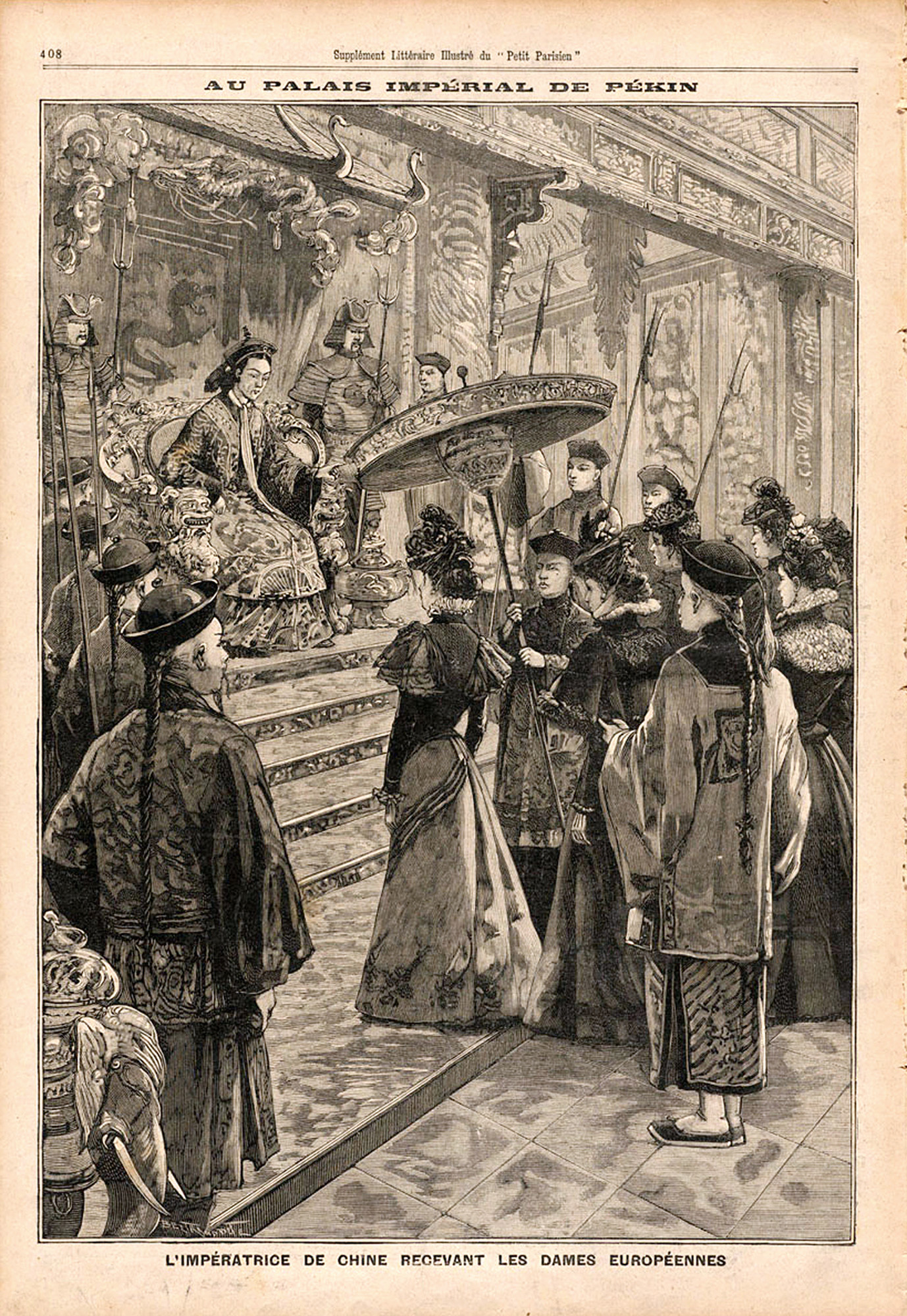
| "Au Palais Impérial de Pékin. L'Impératrice De Chine Recevant Les Dames Européennes" Le Petit Parisien, Supplément Littéraire Illustré Dec 18, 1898 (No. 515) [lpp_1898_12_18_cixi] |
| 1899: The Court & the Foreigners Come into Conflict As the Boxers began their rampage through the countryside, the courtroom in Beijing, dominated by anti-foreign reactionaries, had resolved in 1899 to effort to protect Christians, only non to suppress the Boxers with military forcefulness. On Jan 3, 1900, information technology ordered Yuan Shikai (1859-1916), the new Governor of Shandong, not to use force confronting the Boxers.In a decree to the foreign powers, it alleged: When peaceful and constabulary-constant people practice their skill in mechanical arts for the self-preservation of themselves and their families, or when they combine in village communities for the mutual protection of the rural population, this is only a thing of mutual aid and mutual defense. [ane] The British, American, French, High german, and Italian ministers protested the decree and demanded the firsthand suppression of the Boxers. The court considered officially authorizing the Boxers as militia troops, but Yuan Shikai strongly objected that the Boxers had never been a village militia, simply were only a heretical sect. The foreign powers themselves decided to strengthen guards at their legations. The first conflict between Boxers and foreign troops occurred on May 31 nearly Tianjin when 25 Russian Cossacks rescued a group of European engineers, killing many Boxers.The 1st Intervention: the Seymour Expedition, Defeated (June x–28, 1900) By June 6th the Boxers had cut railway communications between Beijing and Tianjin. The British government minister chosen on Admiral Sir Edward Seymour in Tianjin to send reinforcements to Beijing. His forcefulness of 2000 English, French, High german, Russian, Japanese, and American troops fix out from Tianjin on June x on lath five trains for Beijing. |
| |
| Troops on board trains tin can be glimpsed in these photographs captioned "Divergence from Tientsin of Admiral Seymour'southward Column for Beijing" June, 1900 Source: Visual Cultures in East Asia (View pinnacle image) (View lesser image) [vcea_1900_NA02-02] [vcea_1900_NA02-01] |
| Chinese troops sabotaged the tracks and fought pitched battles with Seymour's troops. Past June xiii, the "Starting time Relief Trek" that had confidently gear up out for Beijing was forced to turn dorsum, abandoning the trains to notice overland routes dorsum to Tianjin. Chinese forces—including Boxer militia, imperial Qing troops, and the Gansu Braves recruited by General Dong Fuxiang—attacked the retreating columns, inflicting heavy casualties. Seymour lost 300 men, and establish himself surrounded by large masses of Chinese peasant militiamen. The strange media at this bespeak kickoff took notice of the big calibration of upheaval in China. |
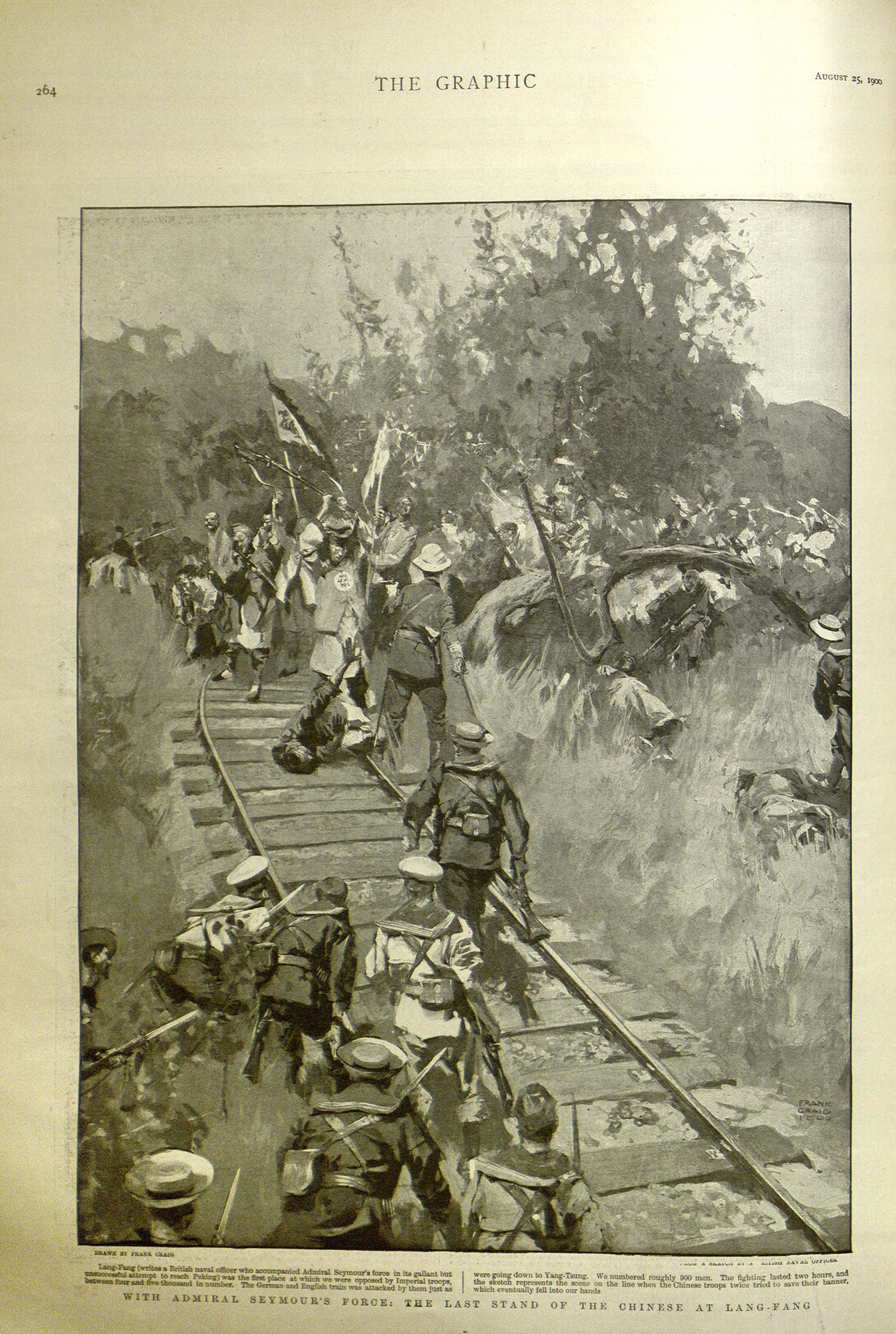
| "With Admiral Seymour'southward Force: The Last Stand of the Chinese at Lang-Fang . Lang-Fang (writes a British naval officer who accompanied Admiral Seymour's forcefulness in its gallant but unsuccessful attempt to reach Peking) was the first place at which we were opposed by Regal troops, betwixt iv and five thousand in number. The German language and English train was attacked by them merely as were going downward to Yang-Tsung. We numbered roughly 900 men. The fighting lasted two hours, and the sketch represents the scene on the line when the Chinese troops twice tried to save their banner, which somewhen fell into our hands." The Graphic, August 25, 1900[lgraphic_1900_031i] |
The Boxers blocked the Seymour expedition on June 13, and a large disengagement of them entered Beijing, burning churches and strange houses in the city. The American Monthly Review of Reviews recounted the Seymour expedition'southward failure to reach Beijing with these words: At that time Admiral Seymour'due south force of English, Russian, German, American, French, and Japanese troops sent out to the relief of the legations was evidently in trouble somewhere between Tientsin and Peking. On June 26, the expedition returned to Tientsin. It had failed to come within 25 miles of Peking, had lost nearly 300 men in battle with comparatively enormous masses of Chinese insurgents and soldiers, and idea itself lucky to escape annihilation. Seymour's failure brought to the world the first realization of the overwhelming nature of the trouble. [2] This account makes articulate that Seymour's trek was a failure, and implies that the disorganized foreign forcefulness profoundly underestimated the strength of the Chinese forces they faced. Seymour'southward troops fought not only against Chinese peasant martial artists and militiamen, simply detachments of the Qing army and highly skilled Gansu Braves led by General Dong Fuxiang. Captions and illustrations in the foreign press, still, give the implication that Seymour almost won the battle, and turned back voluntarily. |
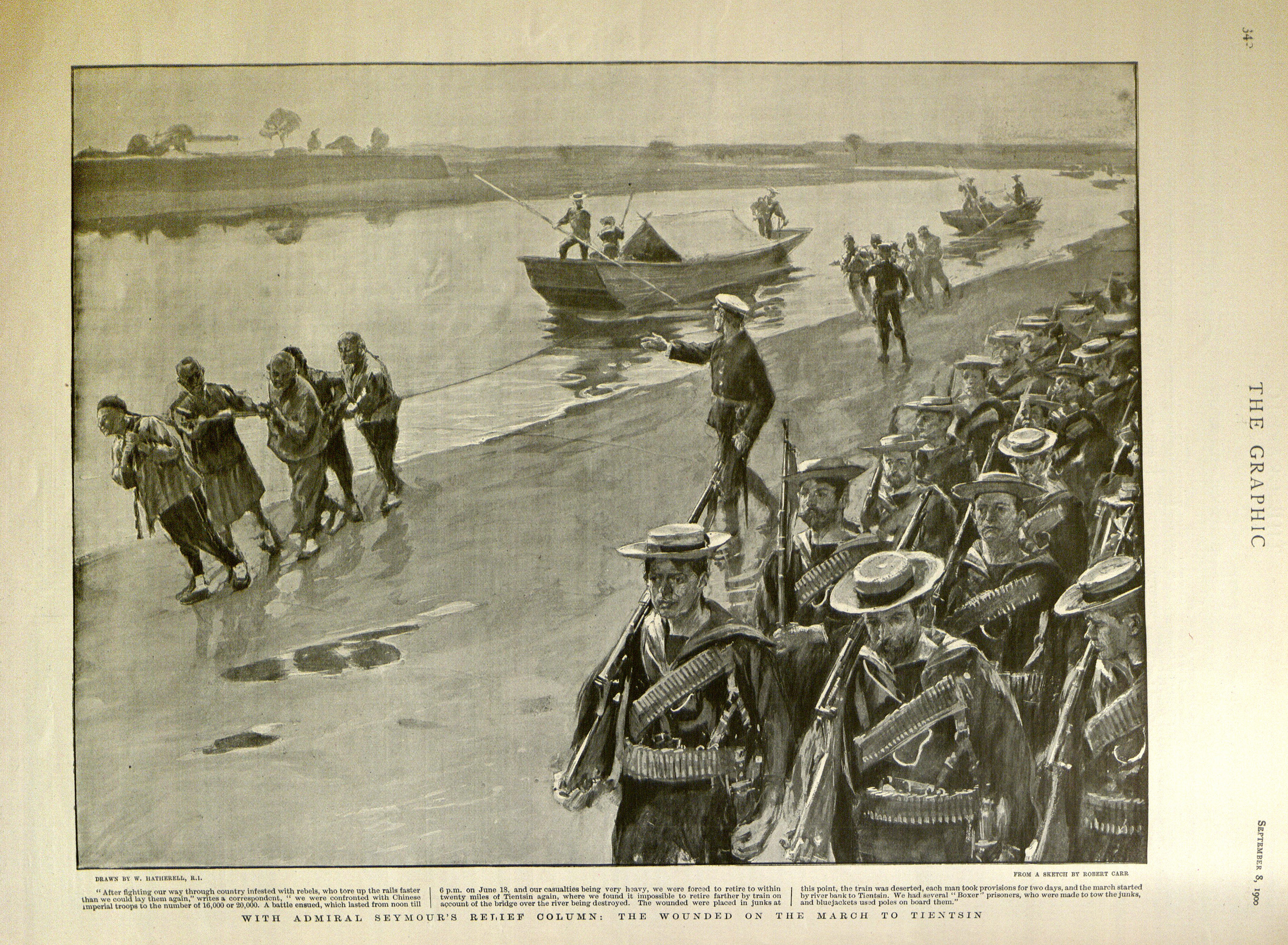
| "Admiral Seymour's Relief Cavalcade: the Wounded on the March to Tientsin. 'After fighting our way through with rebels, who tore upwardly the rails faster than we could lay them again,' writes a correspondent, 'nosotros were confronted with Chinese regal troops to the number of 16,000 or 20,000. A boxing ensued, which lasted from apex till 6 p.m. on June 18, and our casualties being very heavy, we were forced to retire to within twenty miles of Tientsin once again, where we establish it impossible to retire farther by railroad train on account of the bridge over the river beingness destroyed. The wounded were placed in junks at this signal, the train was deserted, each man took provisions for two days, and the march started by river back to Tientsin. We had several 'Boxer' prisoners, who were made to tow the junks, and bluejackets used poles on lath them.'" The Graphic, September 8, 1900 [lgraphic_1900_031i] |
| Chinese New year's day's prints, however, like the graphic that begins this unit shown in a close up detail below, celebrated the victory with colorful scenes of banners, smoke, and troops waving swords, driving back the helpless foreign armies. (For more word of the New year's day'due south Prints, encounter Chapter 2: "The View from China.") |
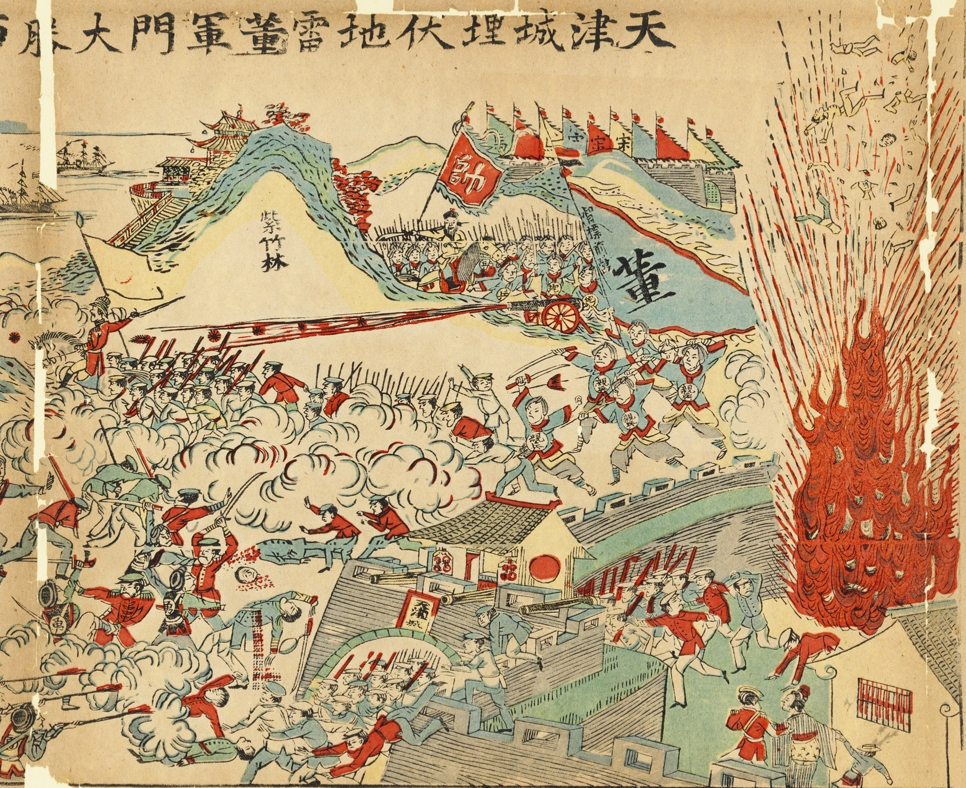
| "A Motion-picture show of an Ambush at Tianjin Metropolis using Land Mines, and the Swell Victory of Commander-in-Chief Dong over the Western Forces. The First Month of Fall in the Gengzi Year of the Guangxu Reign [1900]," (detail). Chinese nianhua woodblock print, 1900. This close-upward item of a nianhua impress shows Chinese forces fighting foreigners in Tianjin. The explosion on the right, depicted as a Buddhist image of hellfire, throws bodies into the air. A Japanese adult female appears inside the enclave on the lesser right. Beheaded foreign soldiers and a volley of cannon balls, banners, and ships announced in the battle. [lgraphic_1900_031i] |
| Many types of maps appeared in Western publications that illustrated the embattled area in China, including illustrative, bird's-heart views like the following, "From the Pei-Ho to Pekin: A Bird'south-eye View of the Disturbed Expanse in Prc." The full-page spread in Leslie's Weekly depicts and describes the trajectory of the Seymour trek. |
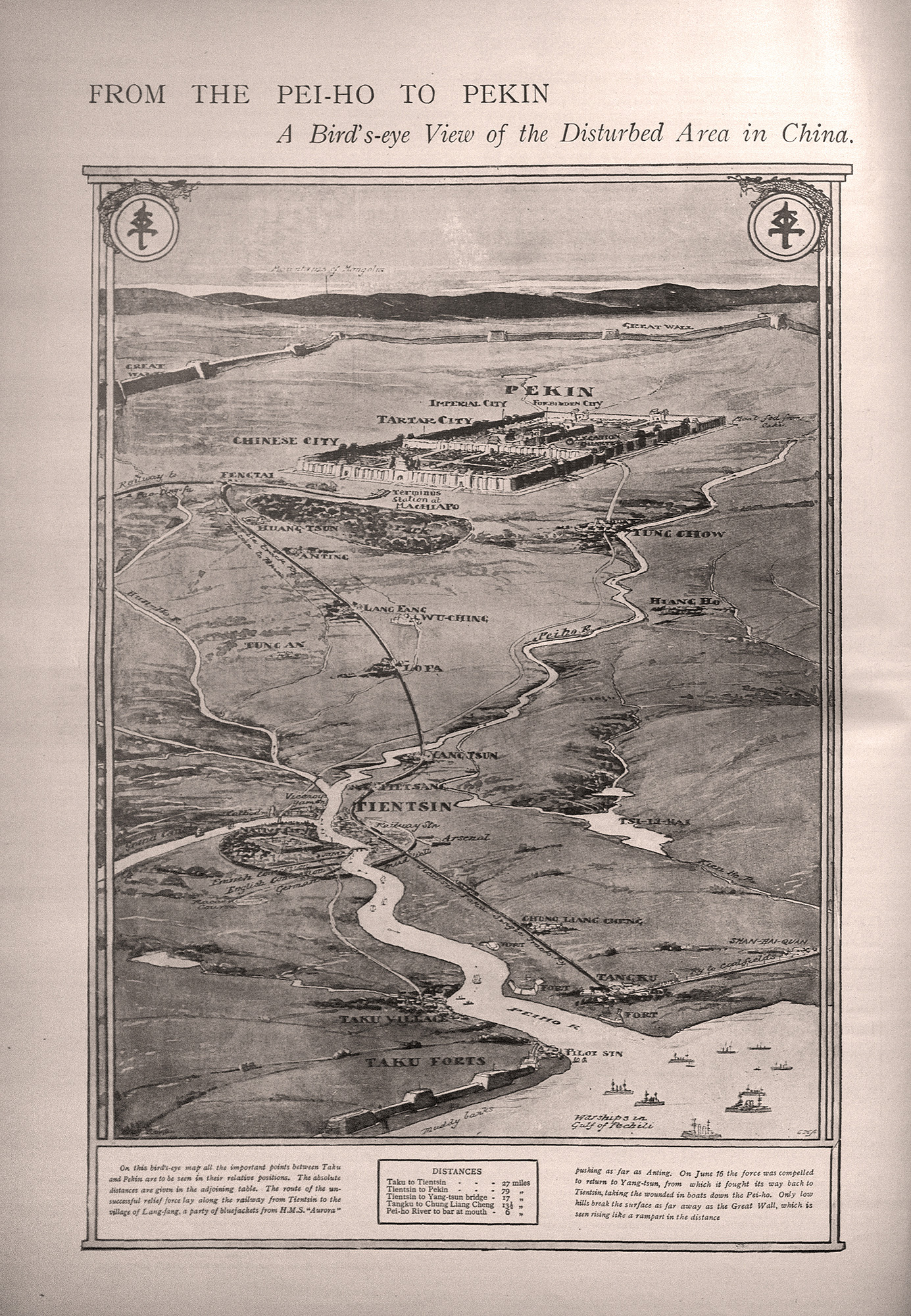
| "From the Pei-Ho to Pekin: A Bird's-eye View of the Disturbed Area in Communist china. On this bird'due south-center map all the important points between Taku and Pekin are to exist seen in their relative positions. The absolute distances are given in the bordering table. The road of the unsuccessful relief force lay forth the railway from Tientsin to the hamlet of Lang-fang, a party of bluejackets from H.Thousand.South. 'Aurora' pushing as far as Anting. On June 16 the forcefulness was compelled to return to Yang-tsun, from which information technology fought its way dorsum to Tientsin, taking the wounded in boats down the Pei-ho. Just depression hills interruption the surface as far away as the Swell Wall, which is seen ascent like a rampart in the altitude. Distances Taku to Tientsin - 27 miles Tientsin to Pekin - 79 miles Tientsin to Yang-tsun bridge - 17 miles Tangku to Chung Liang Cheng - 13 one/2 miles Pei-ho River to bar at rima oris - 6 miles" Leslie's Weekly, 1900 (vol. 90, p. 24) [leslies_1900_v90_2_024] |
| Foreign Powers Attack the Forts at Dagu (June 16–17, 1900) While Seymour was still on the fashion to Beijing, the Allied navies decided to attack the Dagu forts guarding the mouth of the Hai River that led from Tianjin to Beijing. On June 17, after weak Chinese resistance, the Allies assaulted the forts and captured them quickly. Even though the Chinese had modernistic destroyers, they were unable to apply them. The news of the loss pushed the Qing government to support the Boxers unequivocally and to ally with them to expel foreign armies from Chinese soil.This Chinese New Year's impress shows the Chinese defenders firing cannon in a duel with the foreign warships. The New year's prints, like the foreign media, apace broadcast uncomplicated accounts of the battle to a broad engaged public. |
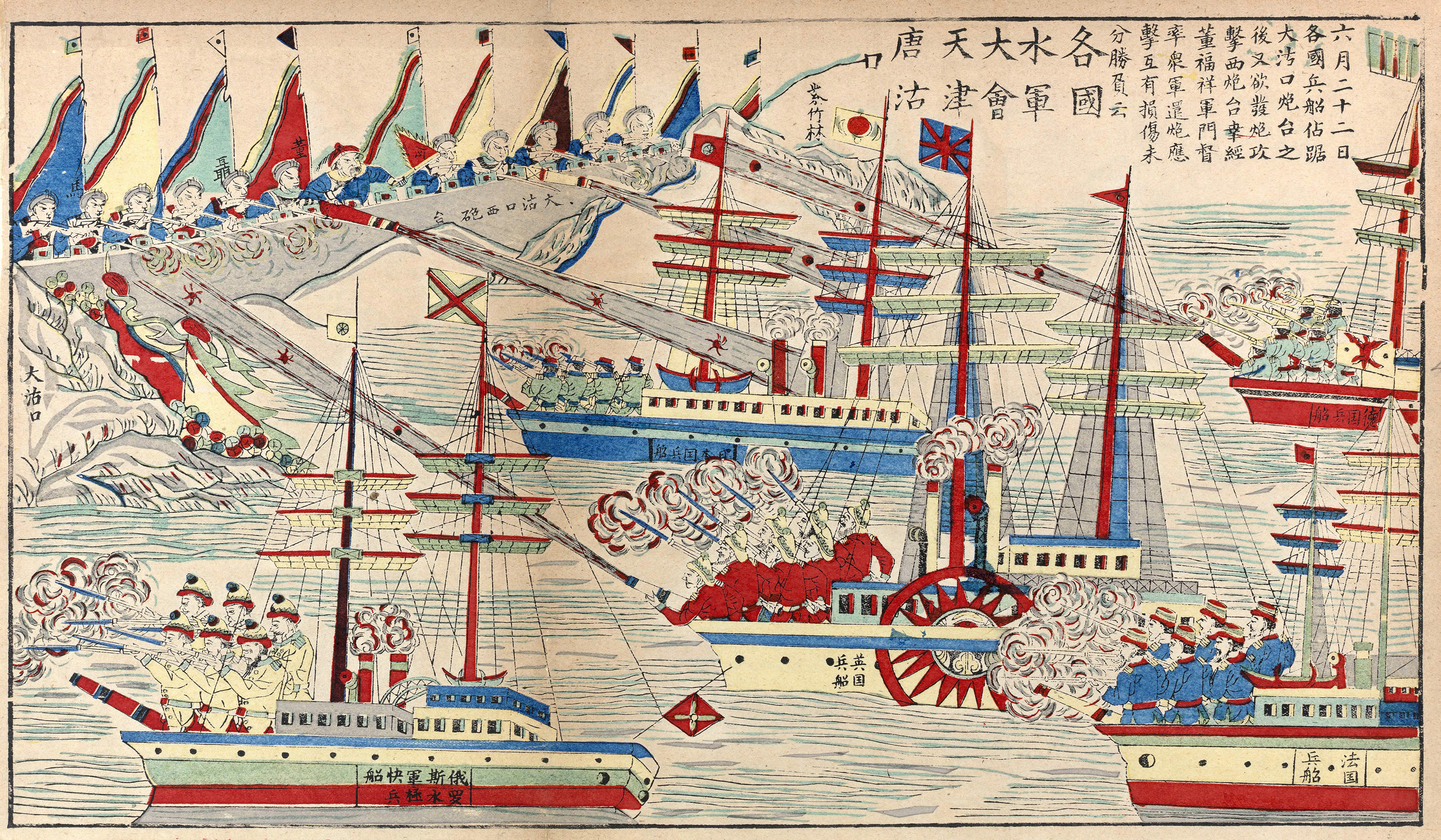
| Strange powers launch a naval attack on the forts at Taku (Dagu) Chinese nianhua woodblock print, 1900 各國水軍大會天津唐沽口 Translation: "All countries' navies gather at Tianjin'southward Tanggu Kou." 率眾軍還炮應擊,互有損傷,未分勝負云 Image, left: 大沽口西炮台;大沽口;俄羅斯水軍极快兵船 Prototype, right: 紫竹林;英國兵船 俄罗斯军极快兵船; 法国兵船 [na12_NatArchives004] |
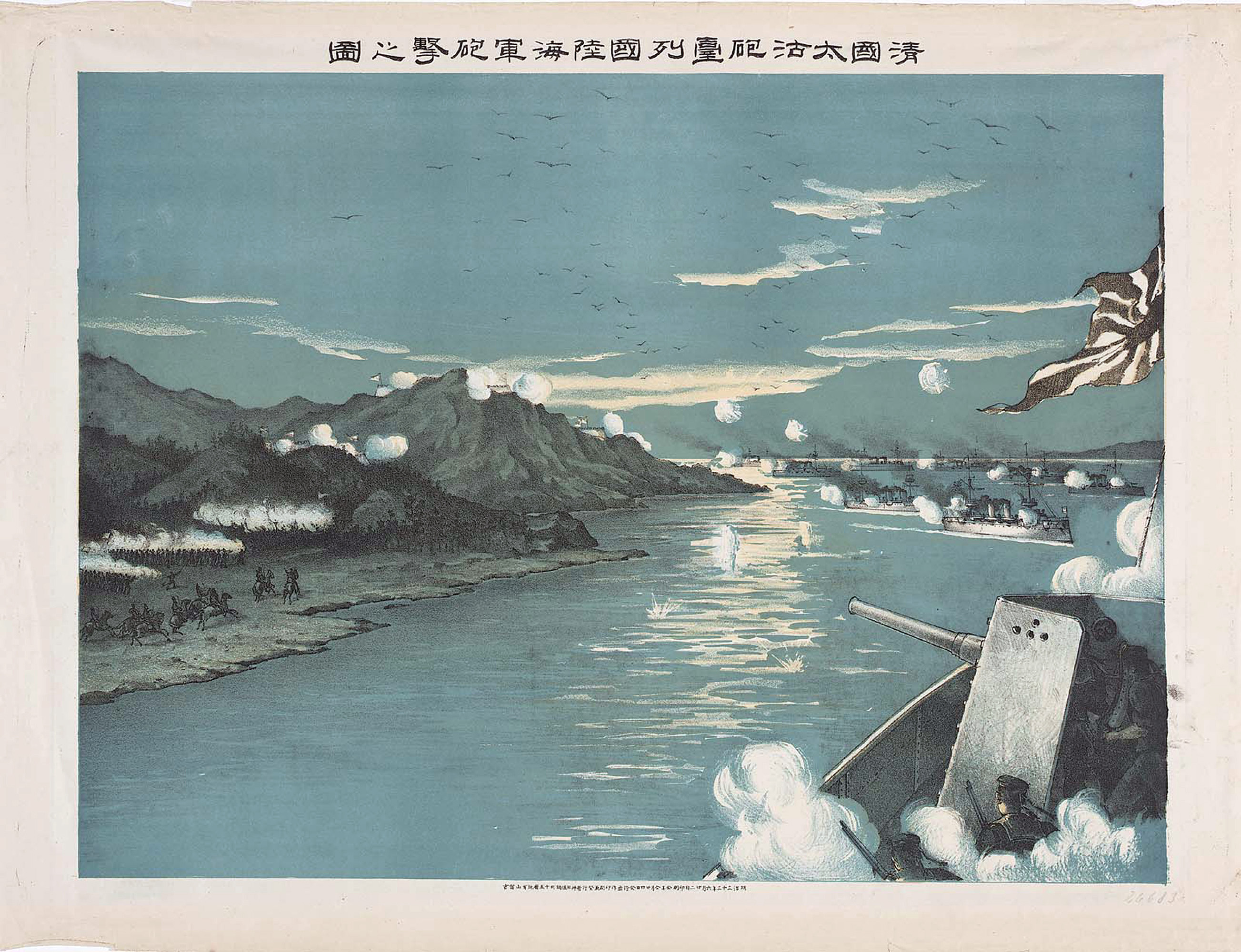
| "H.M.S. 'Taku': A Chinese Destroyer Captured on the Peiho River Lying Alongside H.M.Southward. 'Centurion.'" Detail (above) from 2-folio spread (right) The Graphic, Baronial 11, 1900 [graphic_1900_026_11Aug] | 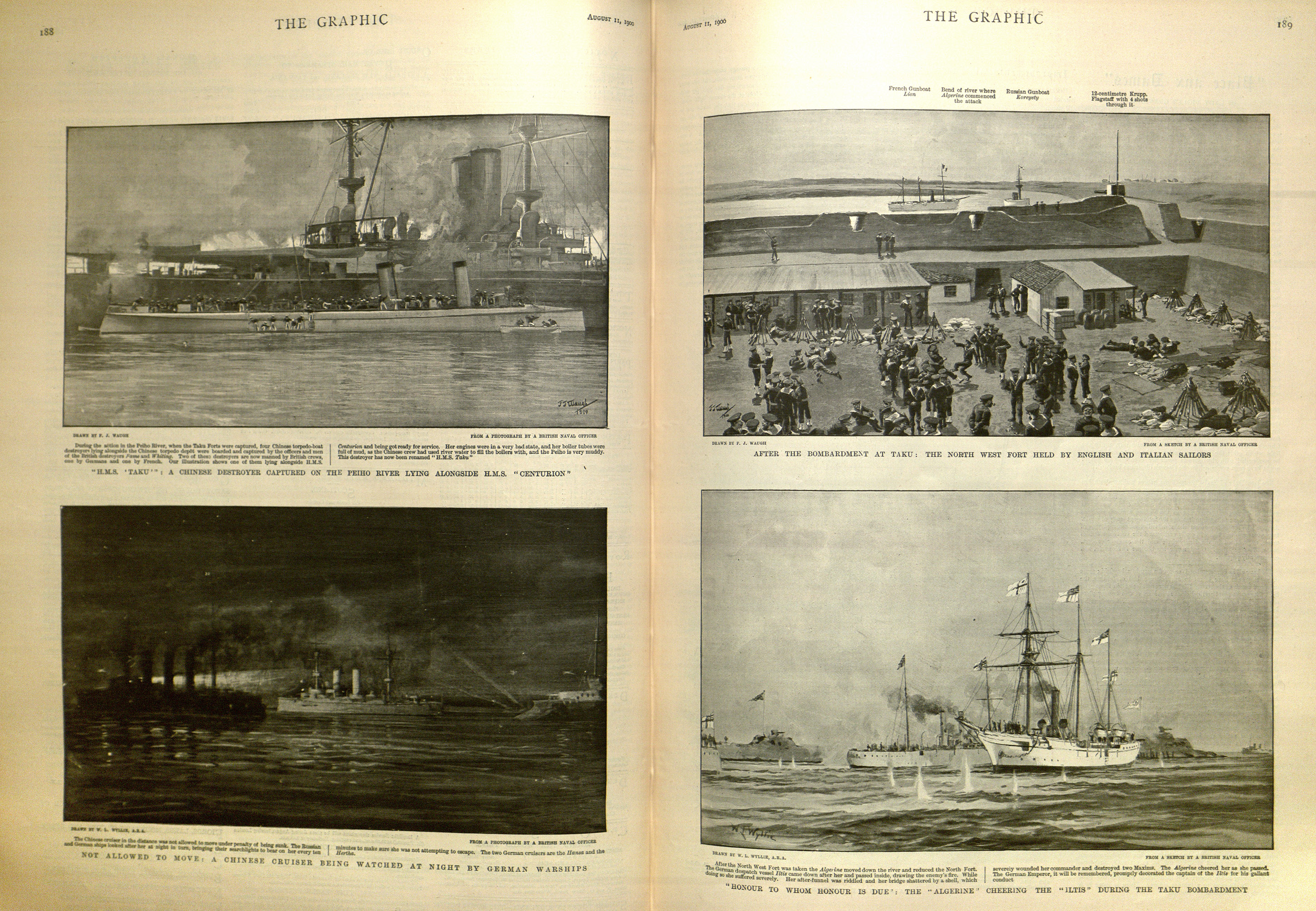 |
| Murder of Foreign Diplomats (June xi & June 20, 1900) By June 1900, the Boxers, supported by Qing troops, had killed the chancellor of the Japanese mission and the German language ambassador, burned the British summertime legation west of Beijing, and cut off telegraph contact of the city. The legation quarter in the southeast district of the city came under siege. Foreign troops shot Chinese civilians who were suspected of being Boxers, and the German minister, Baron von Ketteler, was killed in the street on June xx by Muslim Gansu Braves afterwards he killed a Chinese boy.For a while, the court made conciliatory moves, offering to feed the foreigners in the legations and escort them safely out of Beijing, simply information technology was too belatedly. Now the court openly supported the Boxers, and the siege of the legations began. The assassinations of foreign diplomats stimulated further agitation in Western media against Chinese savagery. The images spread not but through news media, but commercial products, fifty-fifty including chocolate cards. French chocolate cards contain an incongruous mixture of pictures of martyrs, close-up battles, and gruesome executions embedded in advertisements. But these pictures give authentic dates and locations of battles, published in a series, so that the French consumer could keep up with the news from far abroad while enjoying his chocolate safely at dwelling. |
| Shooting of M. Sougiyama"Assassinat du Chancelier de la Légation Japonaise a Manigate (11 Juin 1900)" Chocolat-Louit card [choc-louit03_1900_11June_3] | 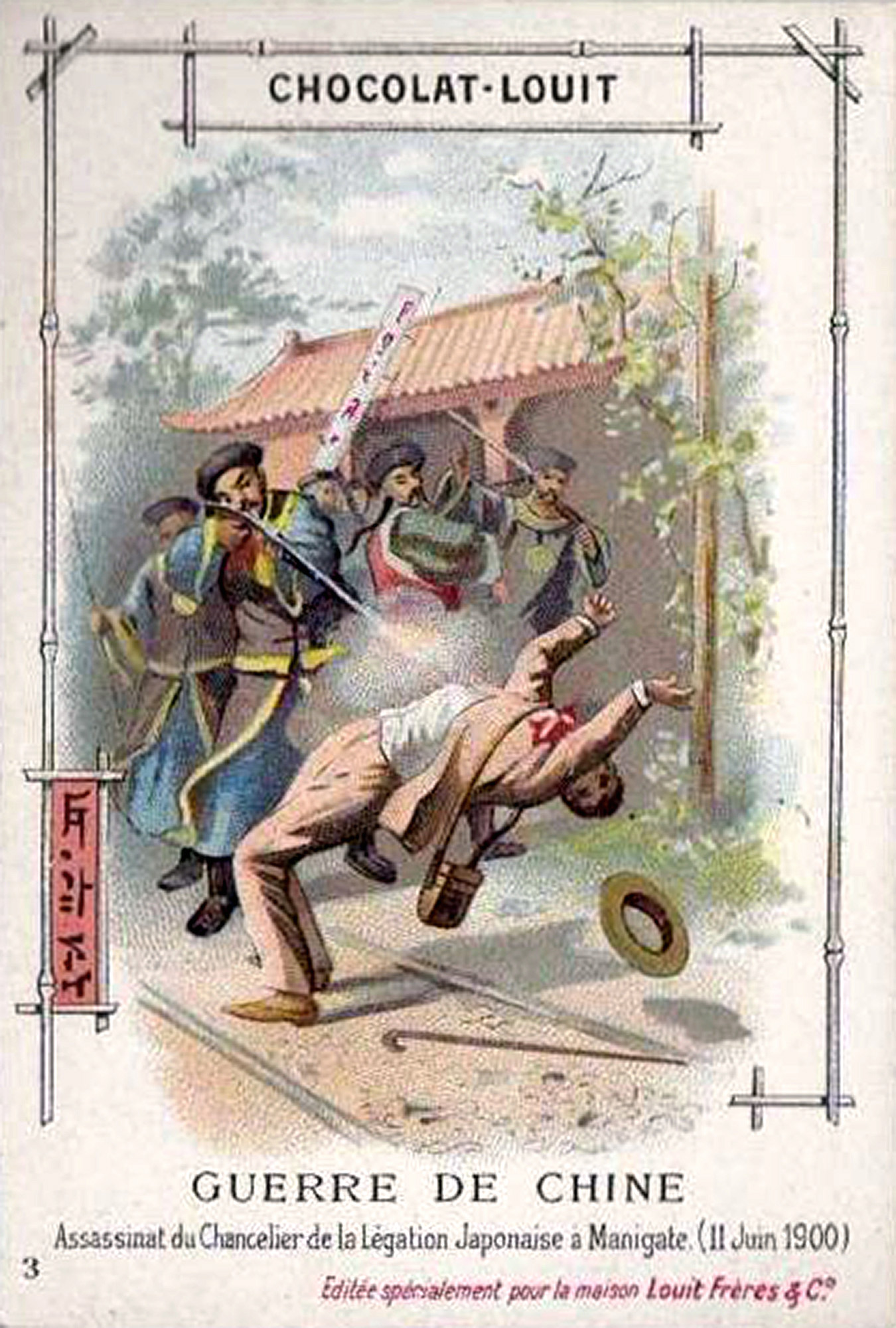 |
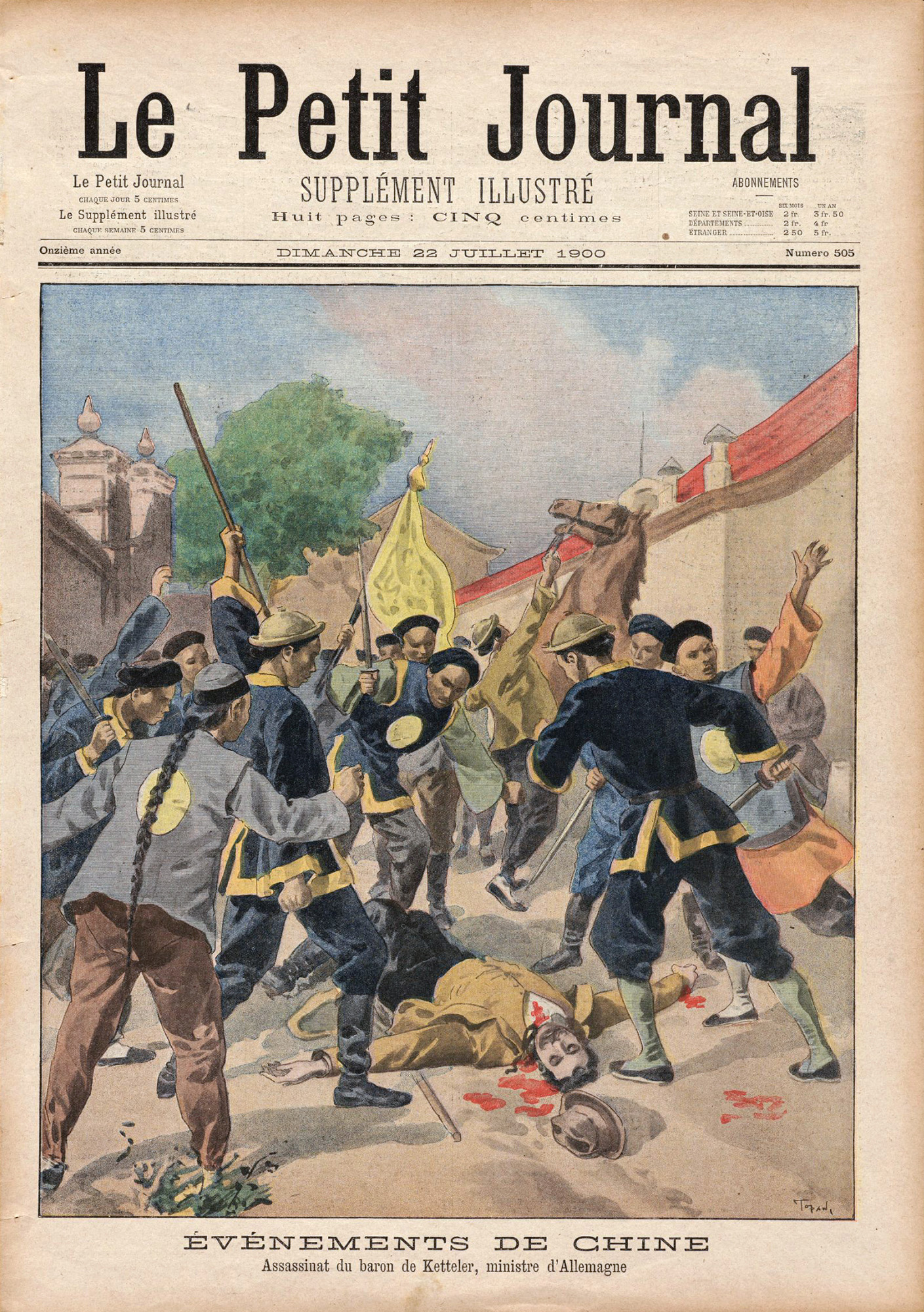
| "Événements de Chine. Assassinat du Businesswoman de Ketteler, Ministre d'Allemagne" Le Petit Journal, Supplément Illustré, July 22, 1900 Source: Widener Library, Harvard Academy [lpj_1900_07_22_widener] |
| Declaration of State of war Against Foreign Powers (June 21, 1900) Past June 16, the Empress Dowager and her Imperial Quango had resolved to resist the entry of foreign troops into the capital. She stated, "The Powers have started the assailment, and the extinction of our nation is imminent... If we must perish, why not fight to the decease?"[3] After the Allied naval forces attacked the Dagu forts that protected the port of Tianjin, the court declared war on June 21.The court formally supported the Boxers but after the declaration of state of war, at present praising them for their patriotism and wishing them success. Qing officers at present collaborated with Boxer militia to enroll more fighters confronting the foreign menace. Wall posters in cities like Tianjin spread the news of the anti-foreign disharmonize. |
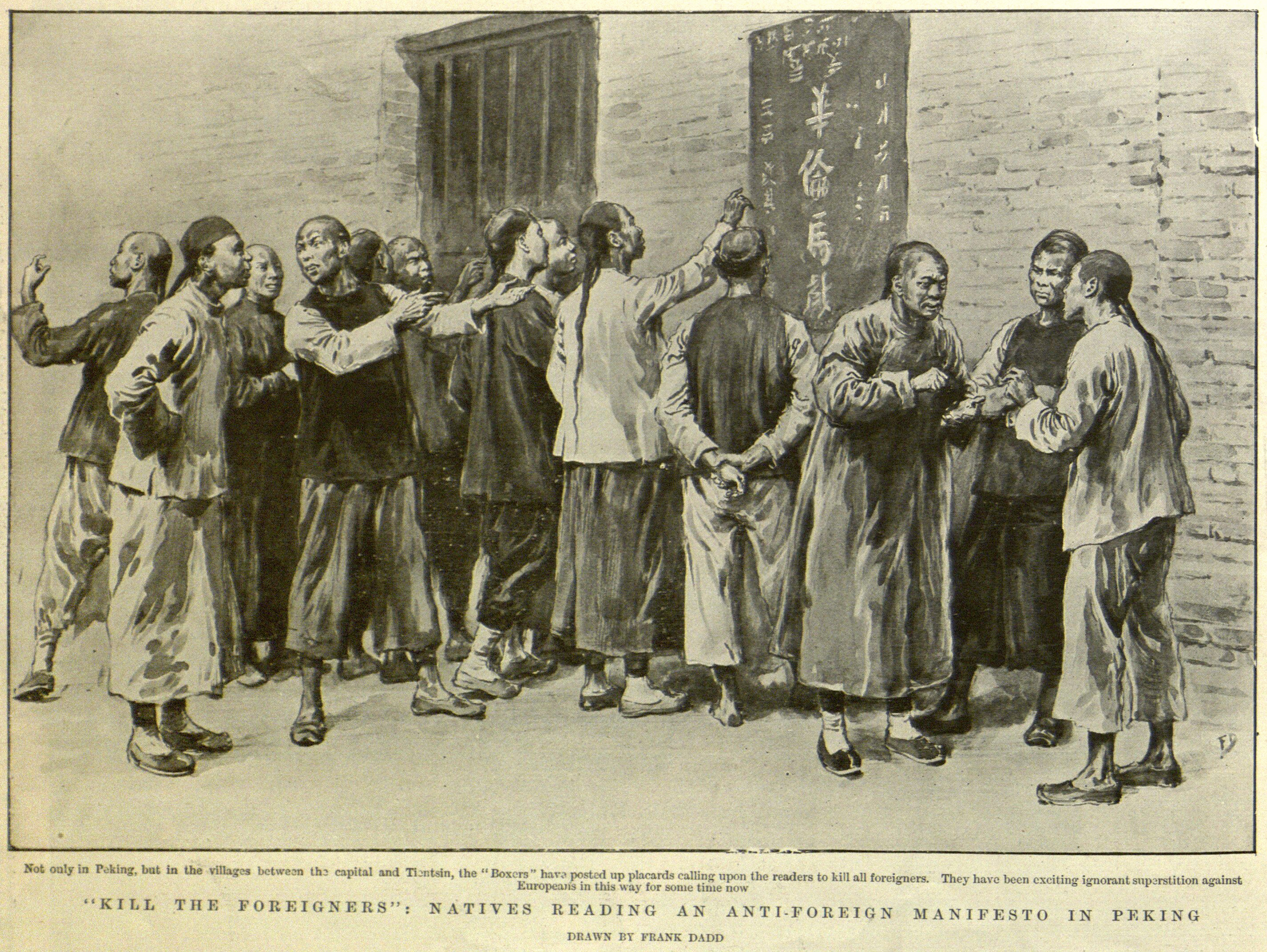
| "'Kill the Foreigners': Natives Reading an Anti-Foreign Manifesto in Peking. Not but in Peking, but in the villages between the capital and Tientsin, the "Boxers" have posted upwardly placards calling upon the readers to impale all foreigners. They have been exciting ignorant superstition confronting Europeans in this way for some time now." The Graphic, June 23, 1900 [graphic_1900_004b] |
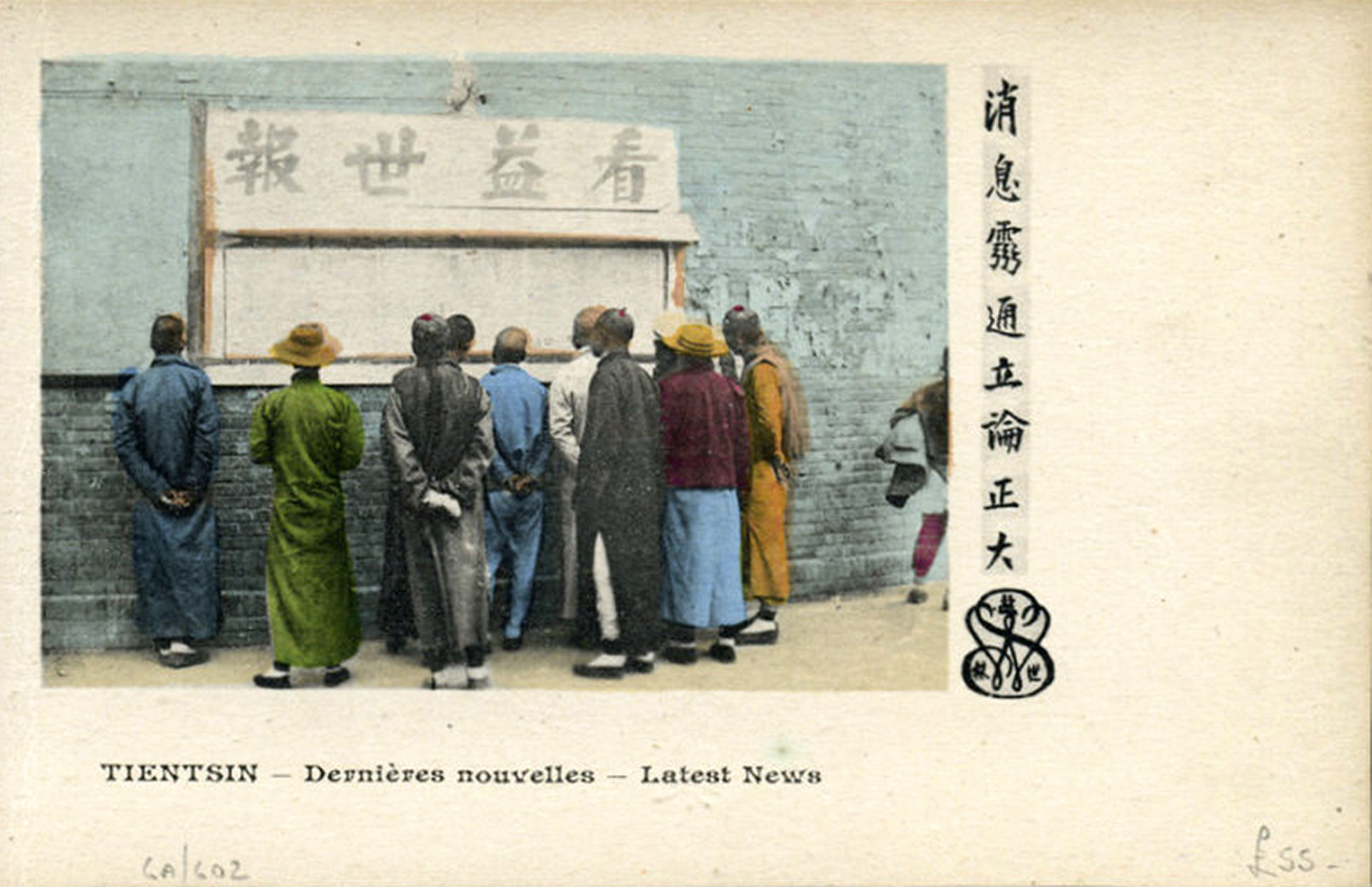
| "Tientsin – Dernieres Nouvelles – Latest News" Translation of Chinese text higher up wall: "World News for Your Benefit." French postcard, Tianjin. [1900s_TientsinCrd_stmpbds] |
| Every bit the Boxers rampaged through Beijing, putting up wall posters calling on Chinese to kill foreigners, foreigners retreated to the legation quarter. The courtroom heard of foreign victories in Tianjin and the decease of the distinguished general Nie Shicheng, leader of a Western-trained ground forces who had fought in the Sino-Japanese State of war. The southern provincial leaders, on the other hand, had no involvement in fighting the strange powers, and they pressed the court to negotiate. This catamenia of the state of war attracted the greatest strange media attention, but data was deficient and unreliable. The foreign press raised fears with sensationalist, inaccurate reports of massacres, stressing the pitiable condition of foreign women trapped in the legations. Few reports mentioned that large numbers of Chinese Christians had also taken shelter within the legation walls. Photographs from within the legation stress the preparations fabricated for defence force and the cooperation amid missionaries, diplomats, and soldiers to maintain the community's morale. |
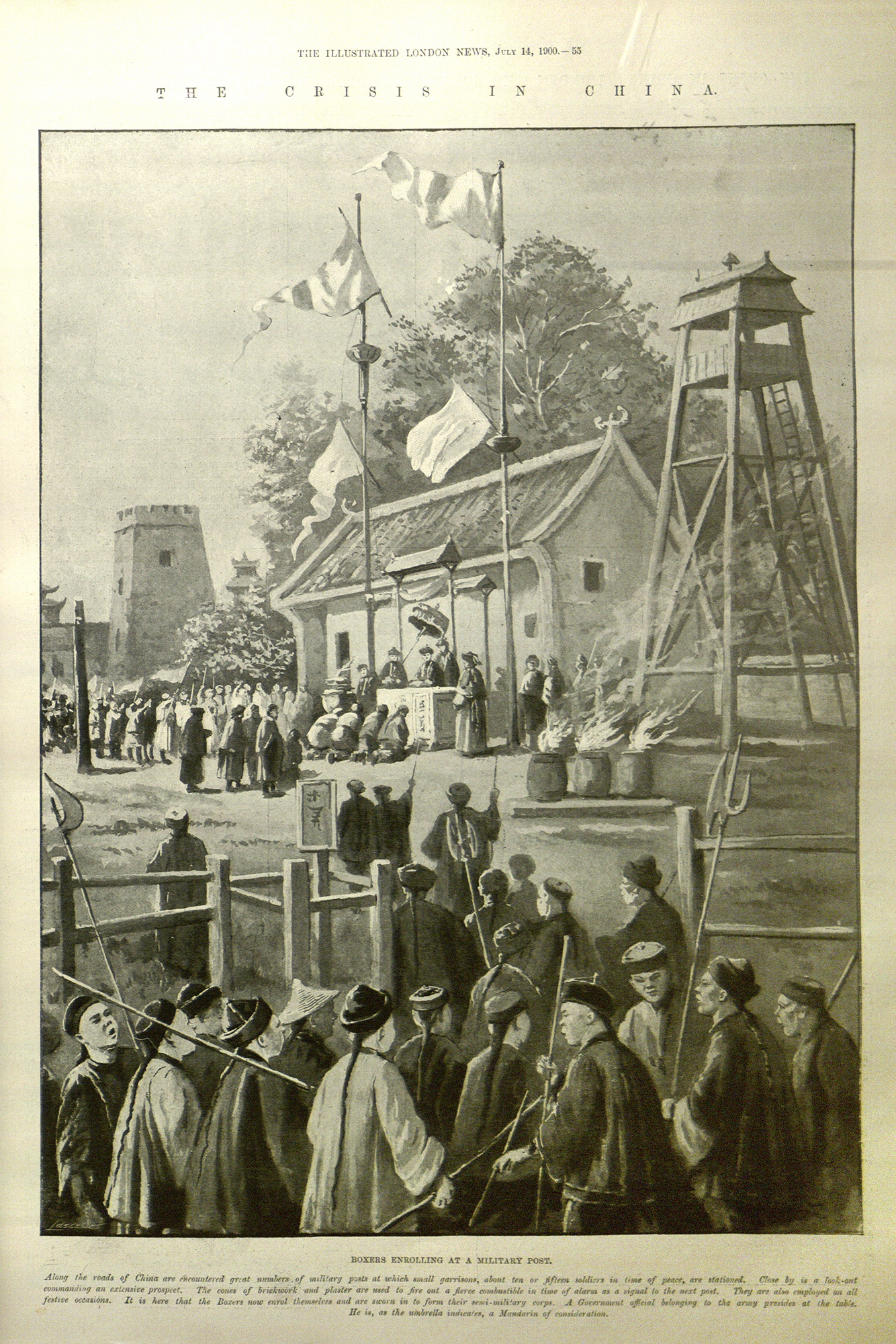
| "The Crisis in China. Boxers Enrolling at a Military Post.Along the roads of Red china are encountered great numbers of military posts at which small garrisons, about 10 or fifteen soldiers in fourth dimension of peace, are stationed. Close by is a look-out commanding an extensive prospect. The cones of brickwork and plaster are used to fire out a trigger-happy combustible in time of alert as a bespeak to the adjacent post. They are as well employed on all festive occasions. It is here that the Boxers at present enrol [sic] themselves and are sworn in to class their semi-military corps. A Government official belonging to the army presides at the table. He is, every bit the umbrella indicates, a Standard mandarin of consideration." The Illustrated London News July 14, 1900 (no. 55) [iln_1900_v2_015] |
| The 55-Day Siege in Beijing (June 20 – August xiv/15, 1900) The siege began on June twenty, and lasted until foreign Armies entered Beijing on August 14 and 15. During these 55 days, 2 sites in Beijing were nether siege: The Northern Cathedral and the Strange Legation Quarter. 900 foreigners and 2,800 Chinese Christians held out in the legation quarter, and 71 priests, nuns, and soldiers, along with three,400 Chinese Christians in the Northern Cathedral. |
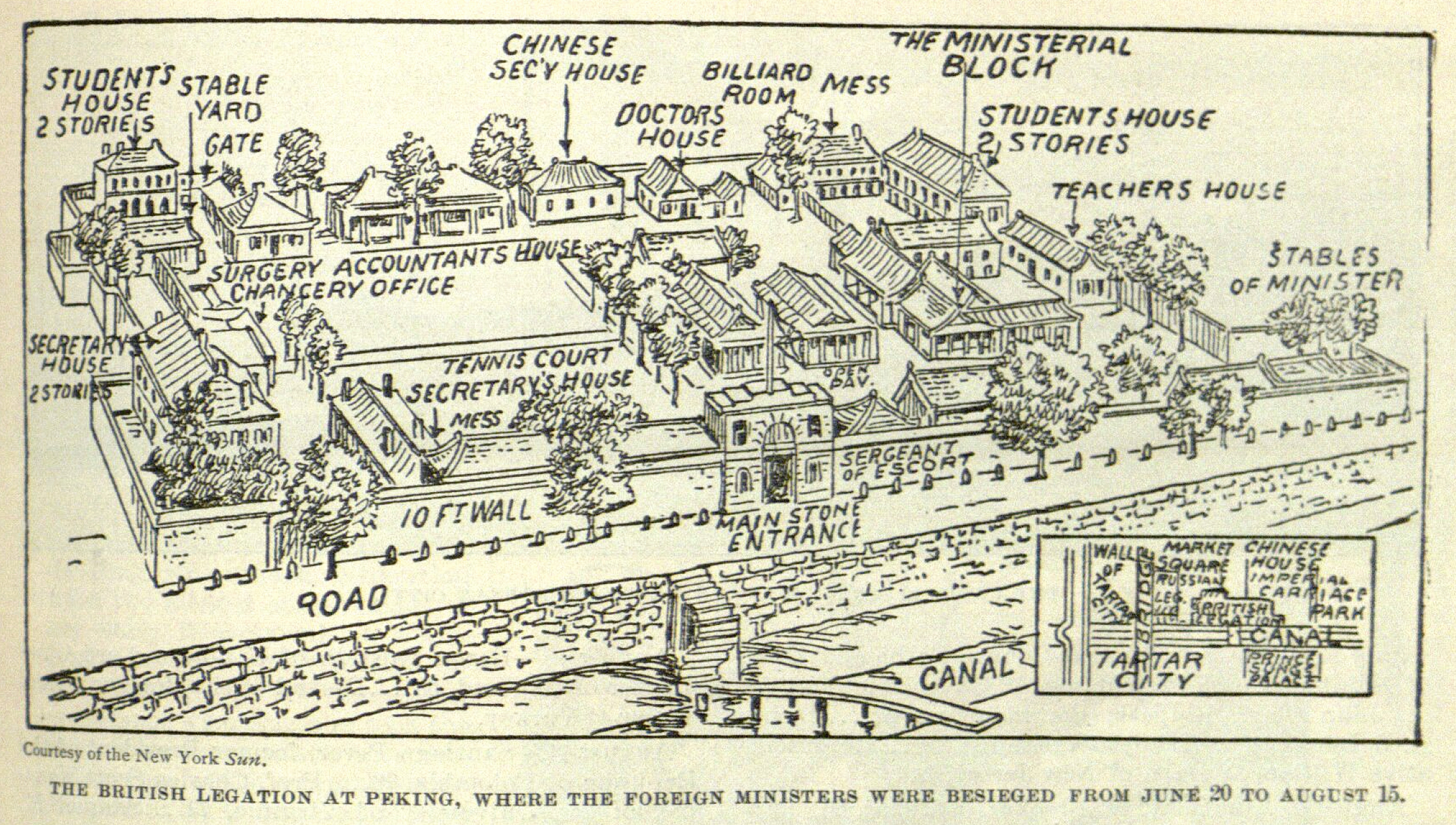
| "The British Legation at Peking, where the foreign ministers were besieged from June twenty to August 15." American Review of Reviews (vol. i, p. 285), 1900 [AmRofR_1900_v1_015_detail] |
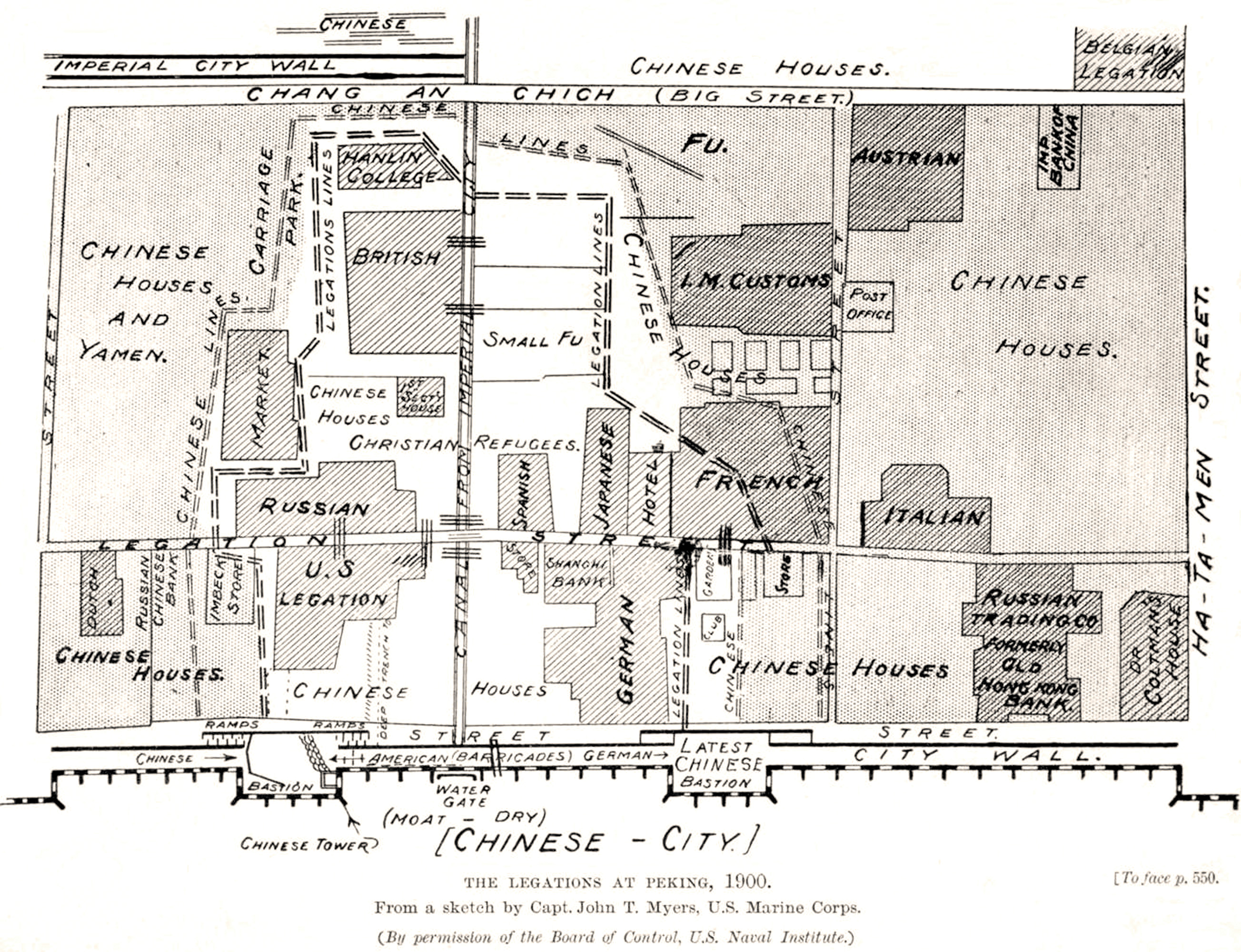
| " The Legations at Peking, 1900" From a sketch past Capt. John T. Myers [Western_Legations_Peking_19] |
| The printing raised fears with sensationalized inaccurate reports. For case, the "Probable Victims of the Massacre at Peking" in the July 21, 1900 Illustrated London News featured portraits of diplomats, missionaries, and children who were the supposed victims of a massacre that never took place. |
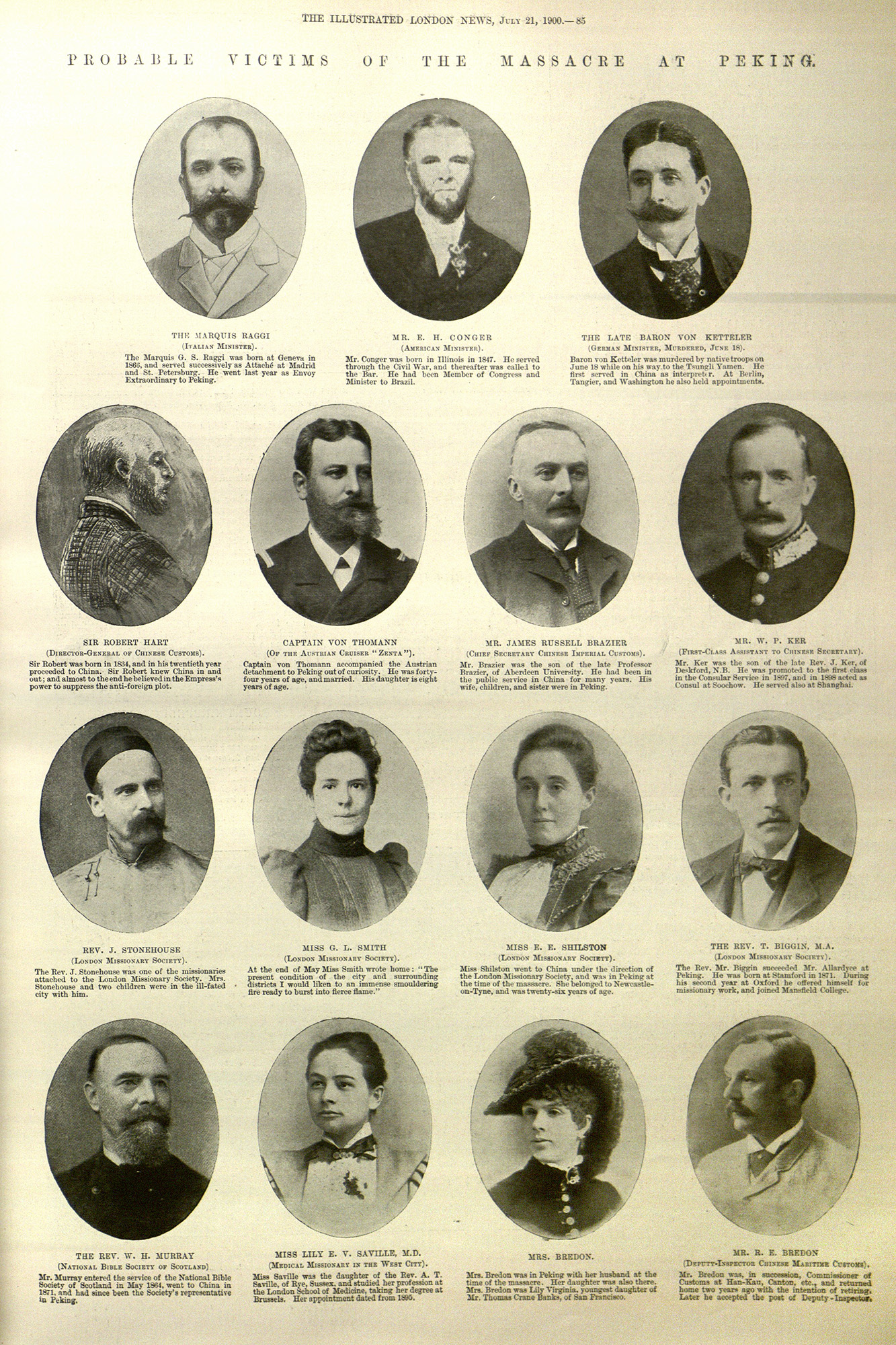
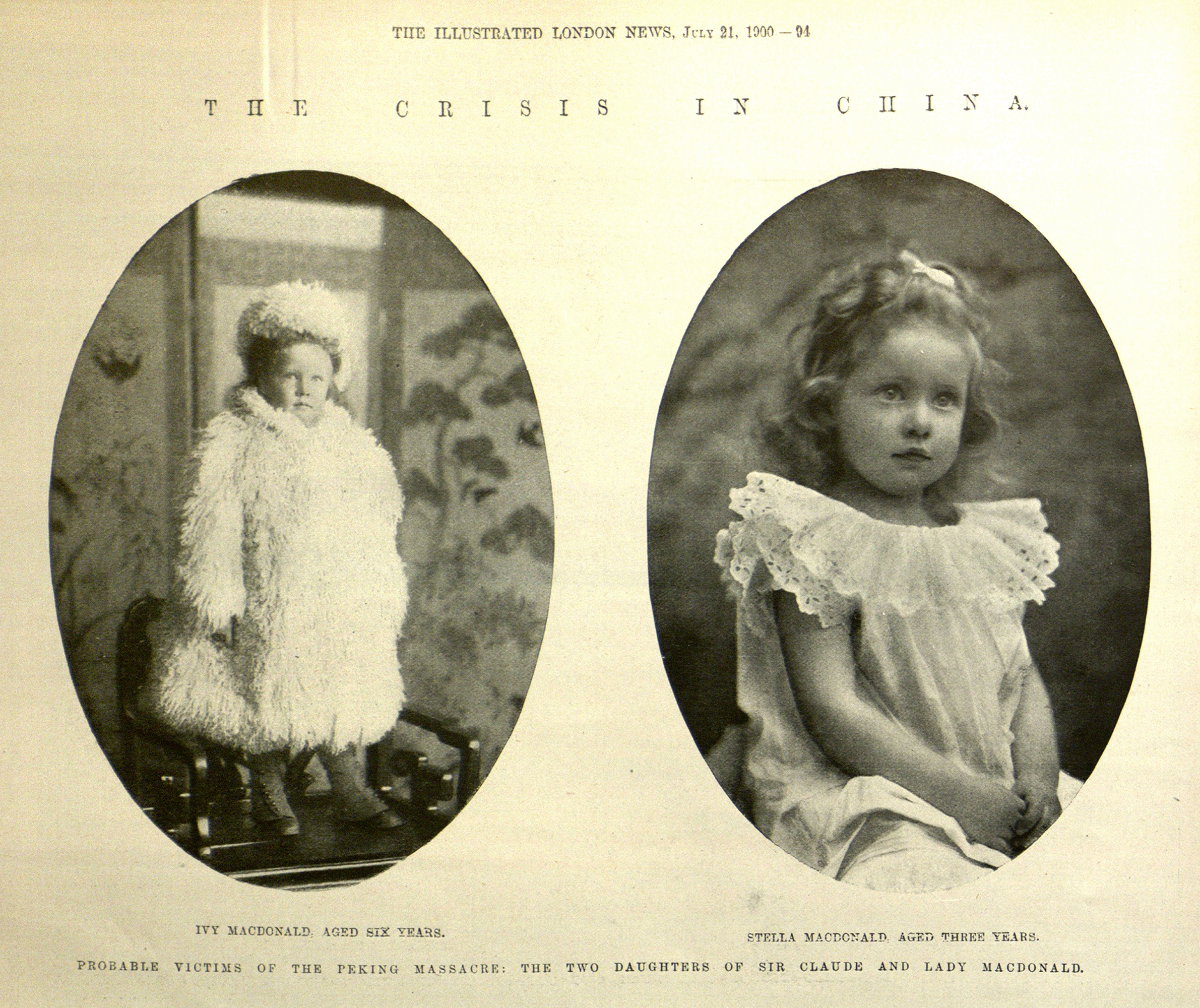 | The Illustrated London News, July 21, 1900 (above, and item left) [iln_1900_v2_021] |
| Photographs taken within the legations reveal siege life, including the internal communication centers, overcrowded makeshift sleeping quarters, nutrient preparation that in time meant butchering the ponies for food, defense of the legations from fire and gunfire, executed and expressionless bodies on the streets, and the graves honoring those killed in the attacks. The photographs offer a rare view of the many Chinese Christians who escaped Boxer attacks by taking refuge in the legations. Despite receiving inadequate shares of provisions, these Chinese refugees contributed heavily to the survival of the residents. |
| Reverend Charles A. Killie photographs from the series "The Siege in Peking" Left: No. 51. Killie'southward captions explain that Chinese Christians assistance combat a "fire started in the Mongol Market by the Boxers." Right: No. 38, the lone scout at the wall, an American Marine "on guard when the photograph was taken, was later on killed." [killie51_46860_yale_36] [killie38_46853_yale_29] |
| Isolation and poor communication heightened the fears of the foreigners both overseas and within the siege. Left: "No. 62. In the British Legation. The only messengers (out of a score or more than sent) who succeeded in getting to Tientsin and return. Although they went in all sorts of disguises, all only those three were understood to have been either killed or captured." Right: "No. 36. In the Methodist Compound. Grouping merely within the big gate, listening to alarming rumors." Photographs from the series "The Siege in Peking" [killie62_46869_yale_45] [killie36_46869_yale_28] |
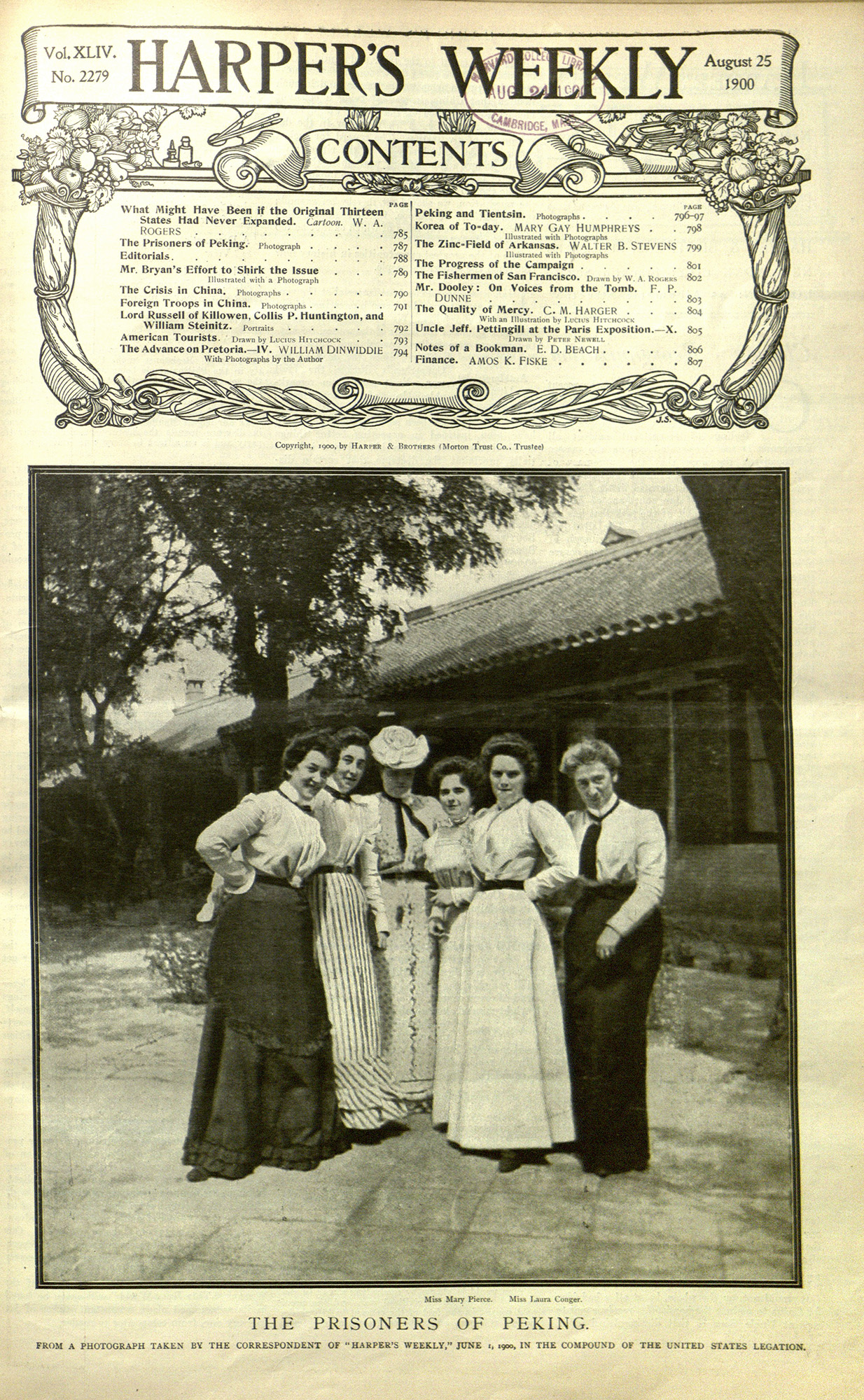
| Images of women in captivity had always been surefire means to arouse public sympathy. The repeated images of women carried in cages portrayed during the Opium War now echoed in portraits of dignified women bars backside the walls of the legations. "The Prisoners of Peking. Miss Mary Pierce. Miss Laura Conger. From a photograph taken by the correspondent of 'Harper's Weekly,' June 1, 1900, in the Chemical compound of the United States Legation." Harper'south Weekly, August 25, 1900 [harpers1900_07b_v2b_019] |
| Battle of Tianjin (July 13–fourteen, 1900) Tianjin, a large city of one million Chinese on the coast southeast of Beijing, independent a substantial foreign settlement of near 700 people along the banks of the Hai River. On June fifteen and 16, Boxers from the countryside destroyed Christian churches in the metropolis, killed Chinese Christians, and attempted to assail the foreign settlement. At this point, the Qing authorities decided to back up the Boxers, besieging and bombarding the foreigners. Afterwards the failure of Admiral Seymour's efforts, the Allies prepared a large forcefulness to assault the metropolis and heighten the siege. Japanese soldiers bankrupt through the south gate while Russians bankrupt through the due east gate, and the Chinese soldiers withdrew. The Centrolineal forces, however, had no unified command, so they quickly turned to annexation, rape, and acts of vengeance against Chinese civilians. The very able general Nie Shicheng was killed, leaving only Dong Fuxiang and his Muslim Braves to resist the march of the foreign armies on Beijing. The impressive resistance of Chinese troops at Tianjin, however, forced the allied armies to delay their final advance until Baronial. The images shown here portray Chinese Christian refugees, Allied troops, and dramatic—though imaginary—battle pictures by Japanese and Chinese artists. |
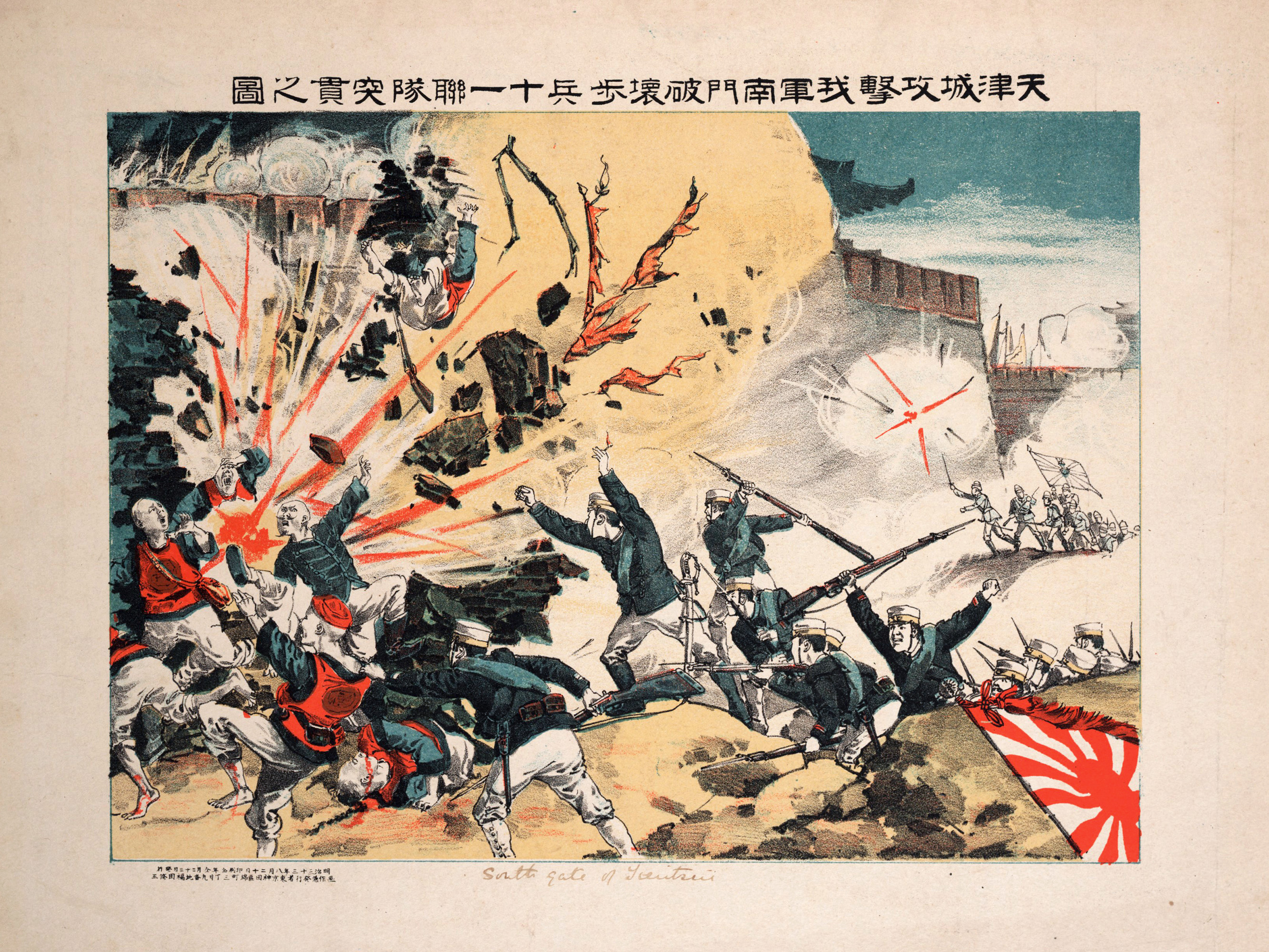
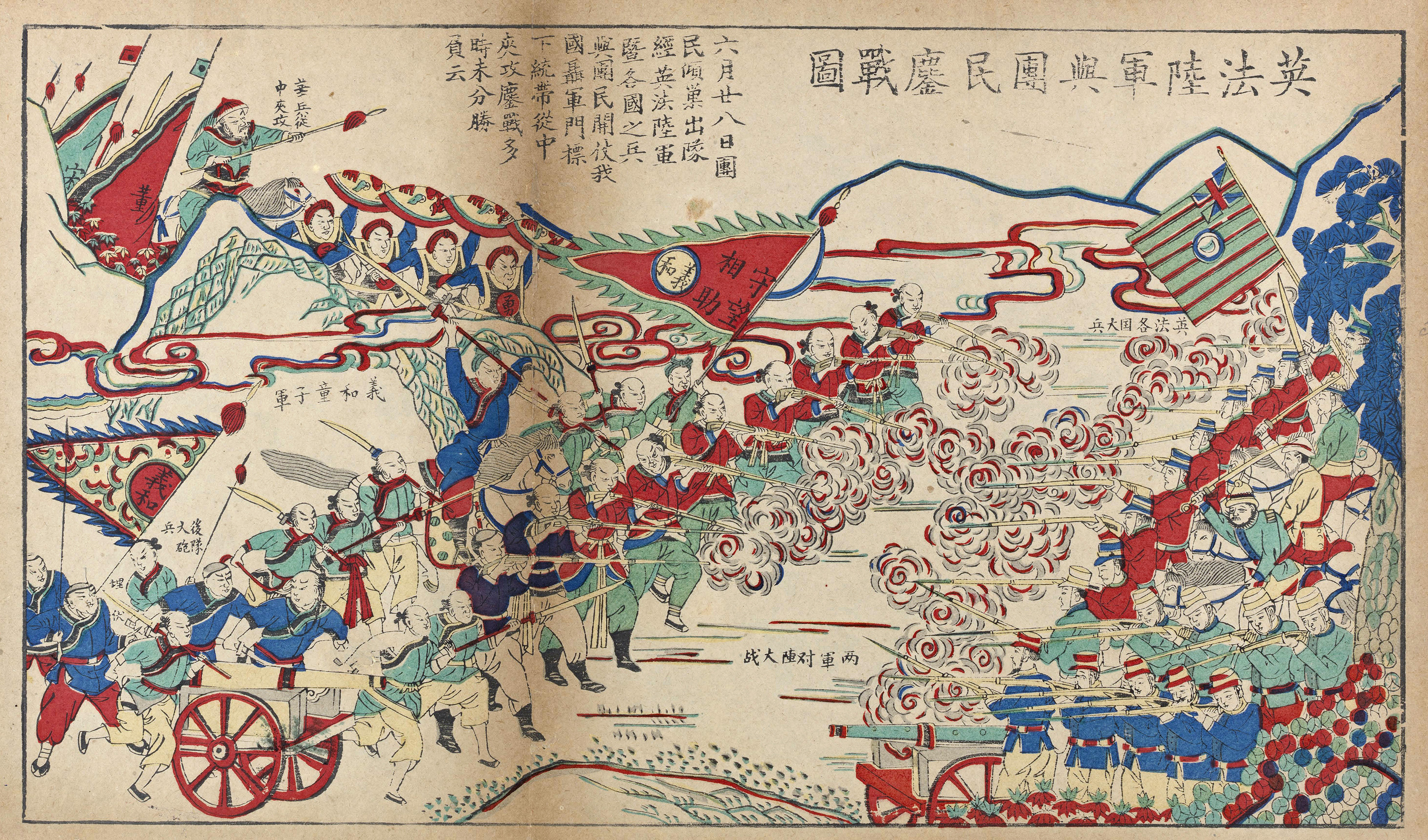
| 陸軍與團民鏖戰圖 Translation: "A Battle Picture of the Bitter Fight Betwixt the [Western] Land Regular army and the Boxers" 六月廿八日,團民傾巢出隊,經英法陸軍暨各國之兵與團民開仗, Prototype, upper left: 華兵從中夾攻;義和童子軍;後隊大砲兵埋伏 Paradigm, center: 守望相助 義和;兩軍對陣大戰 Image, correct: 英法各國大兵 Chinese nianhua New year's day's print, 1900 [na05_NatArchives002] |
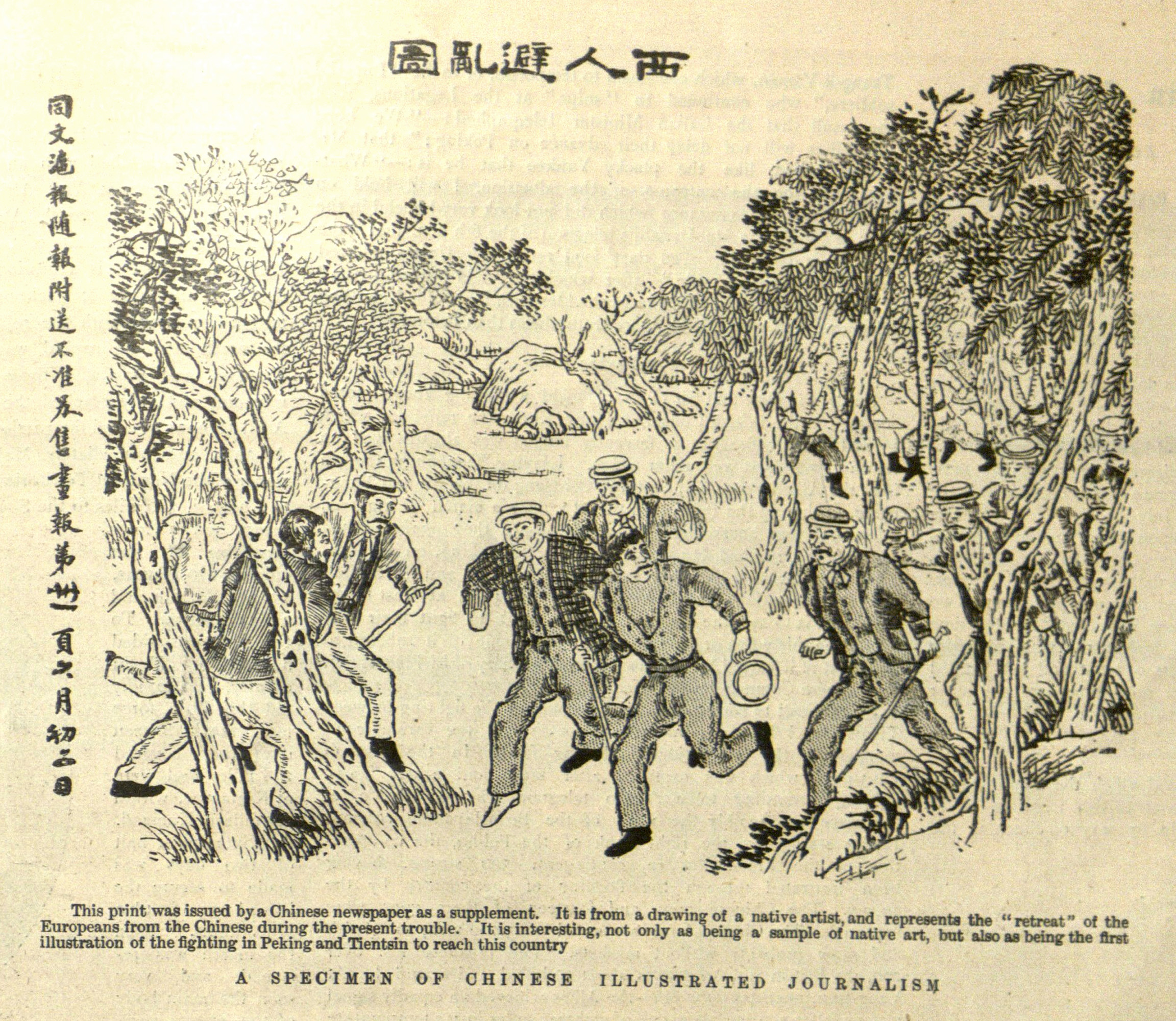
| Translation: "Image of the Westerners Fleeing Disaster" English text: "A Specimen of Chinese Illustrated Journalism. This print was issued past a Chinese paper every bit a supplement. Information technology is from a drawing of a native artist, and represents the 'retreat' of the Europeans from the Chinese during the present trouble. It is interesting, now but as being a sample of native fine art, merely also every bit existence the first analogy of the fighting in Peking and Tientsin to achieve this country." Cartoon from the Chinese newspaper of Tientsin, "Tung-Wen-Hu-Pao" Reproduced in The Graphic, August xviii, 1900 [graphic_1900_030] |
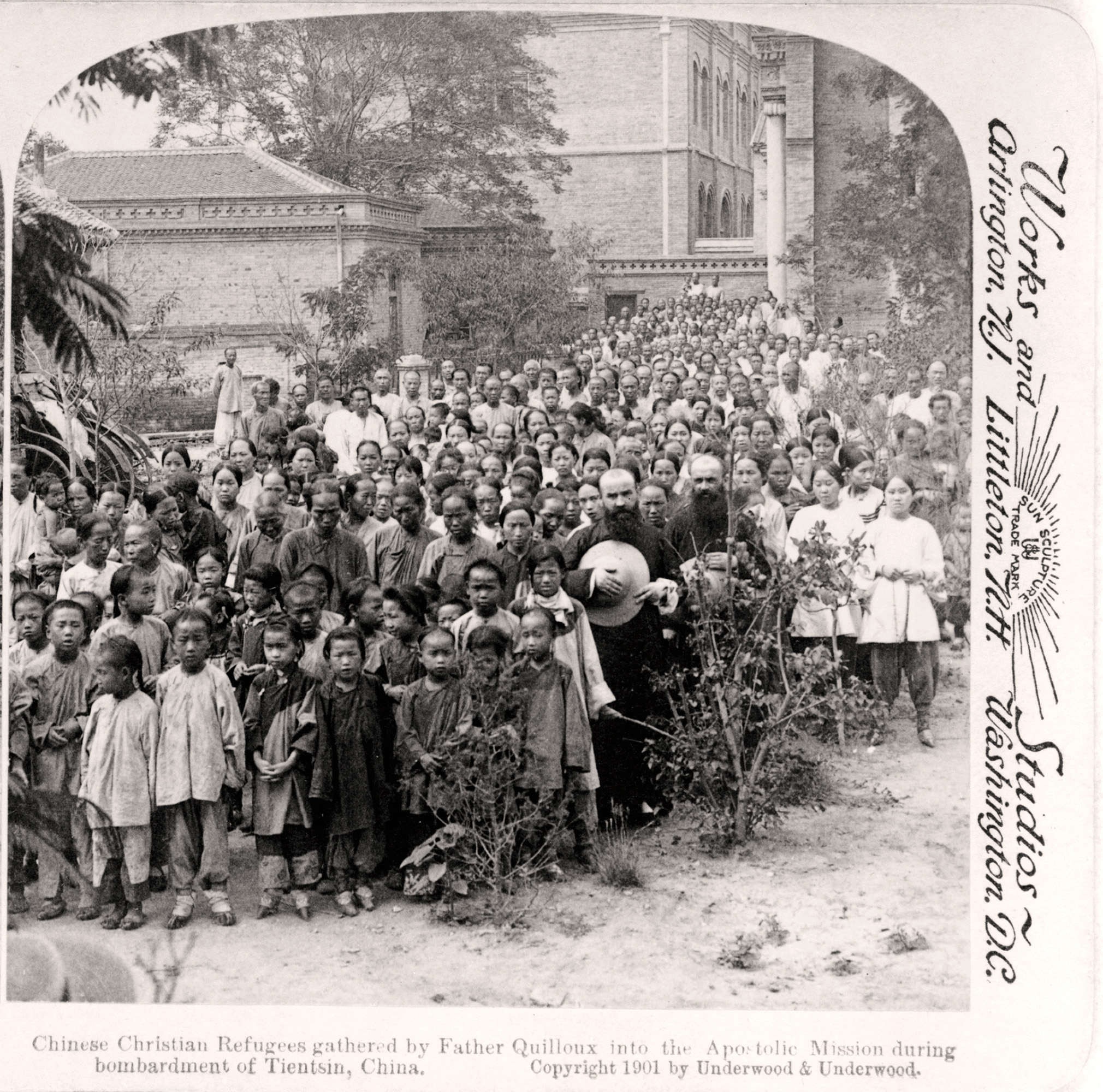
| "Chinese Christian Refugees Gathered past Father Quilloux into the Apostolic Mission During Battery of Tientsin, Prc." Detail from stereograph Source: Library of Congress [libc_1901_3c03013ub] |
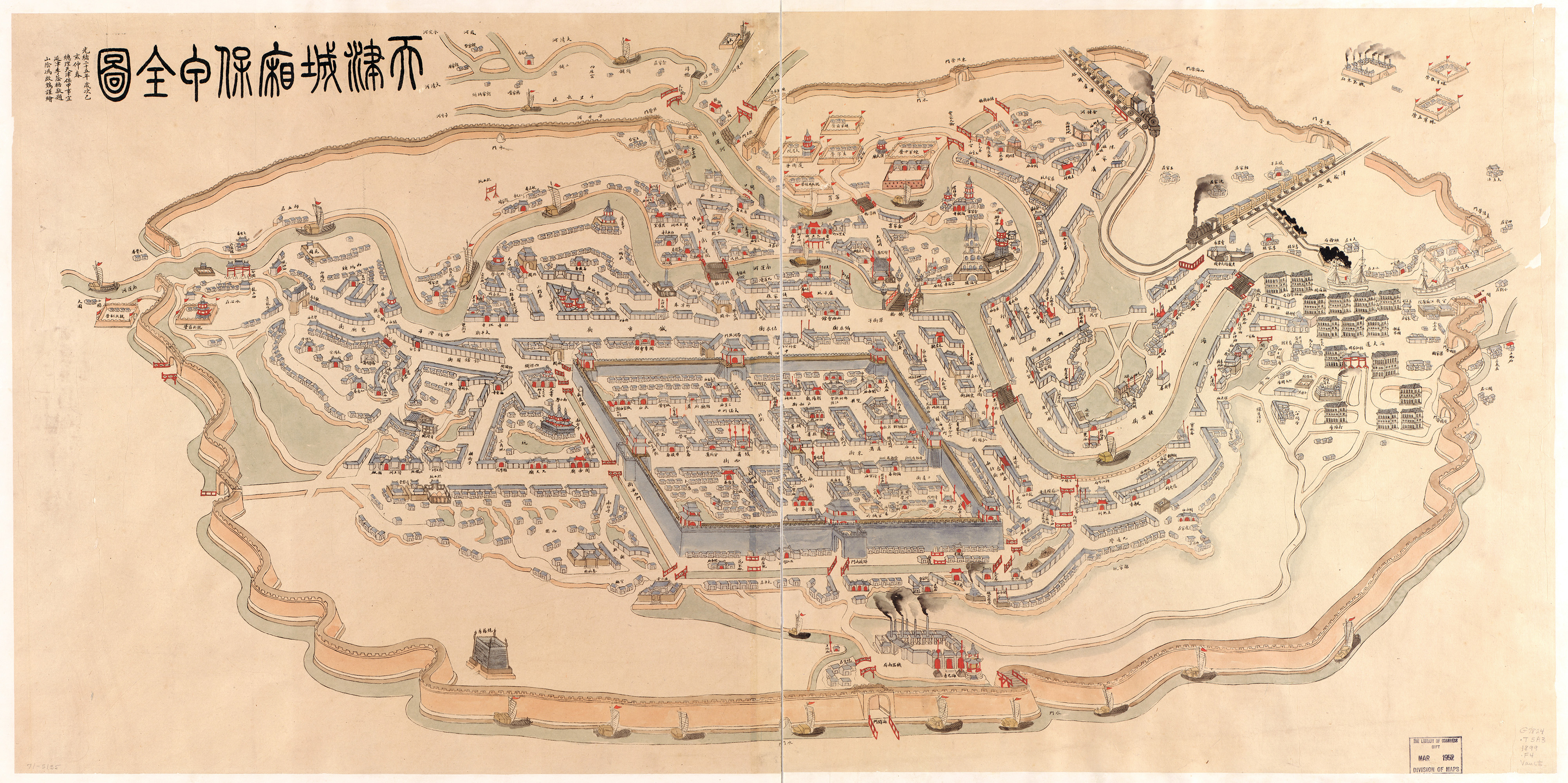
| 天津城廂保甲全圖 Translation: "Consummate Map of the Community Self-Defence force System of the Walled City of Tianjin and its Environs," 1899 Artist: Feng Qihuang Source: Library of Congress [1899_tianjin_ct002306_map_L] |
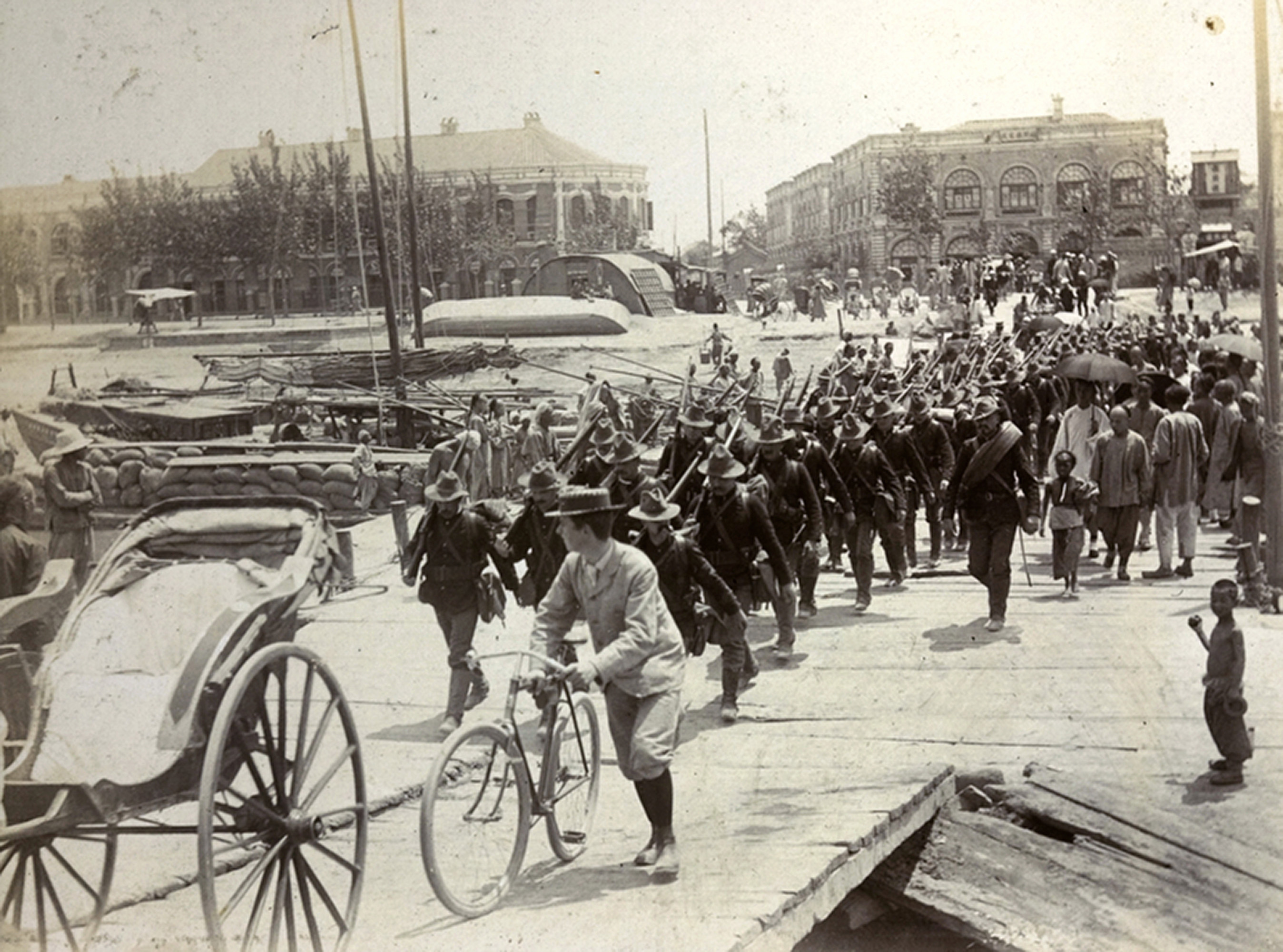
| The 2nd Intervention: March on Beijing (August four–14, 1900) Foreign armies gathered in Tianjin to join in an unprecedented international brotherhood of rivals, having chosen a commander, Alfred von Waldersee, who was still far away in Federal republic of germany. The troops departed under command of British General Gaselee. The main force of the "8-Power Expeditionary Army" in fact included soldiers from only five nations (Germany sent a small-scale forcefulness that turned back later the offset battle, and Republic of austria-Republic of hungary and Italy sent only small forces). Most of the British forces were Indian troops. The full size was almost 18,000 men, consisting of eight,000 Japanese; 4,300 Russian infantry, Cossacks, and artillery; 3,000 British infantry, cavalry, and artillery; 2,500 U.S. soldiers; and an 800-man French brigade from Indochina. |
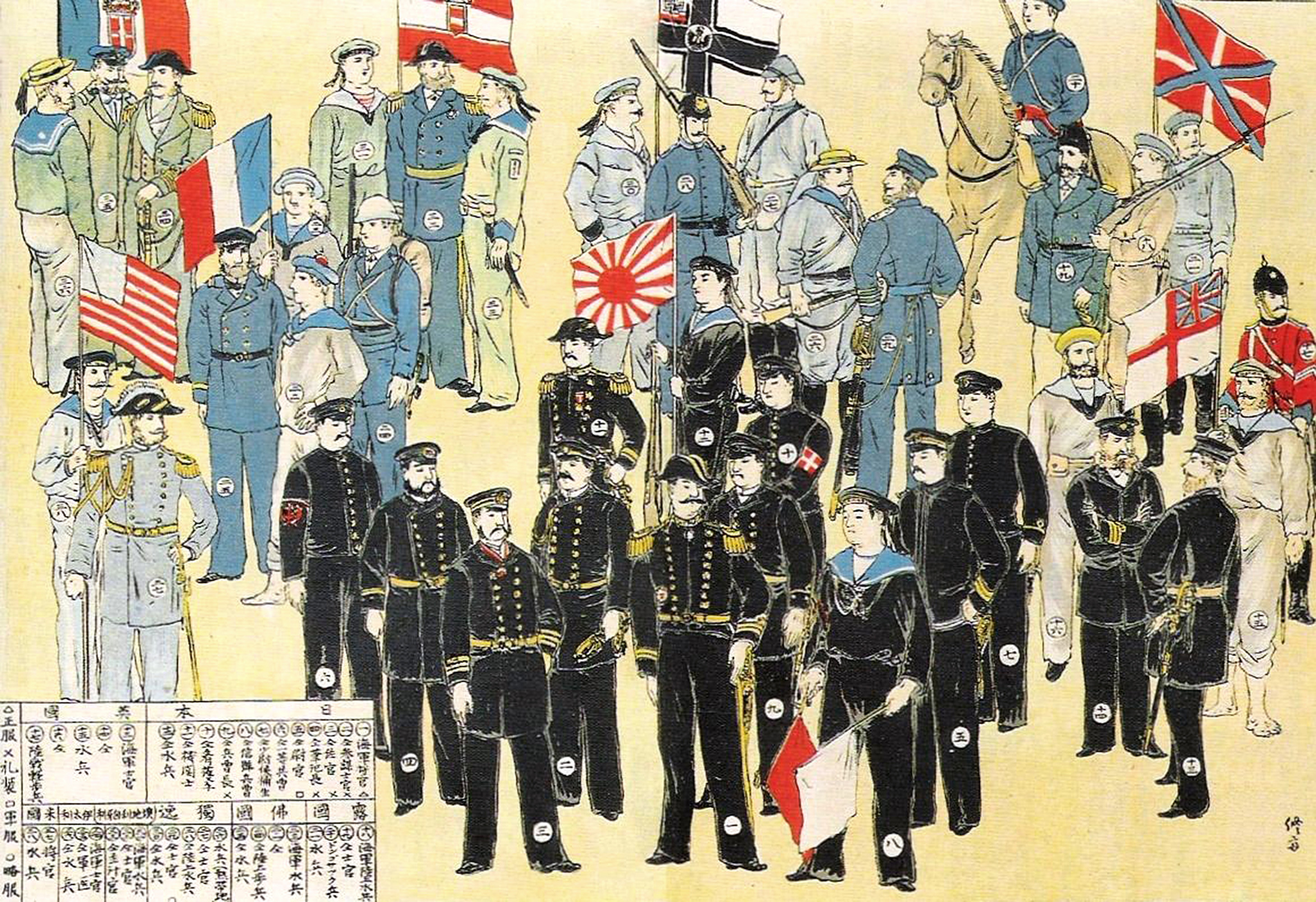
| "8-Nation Alliance with their Naval Ensigns," 1900 "Allied International Forces by guild of troop size: Japan, Russia, U.k., France, United States, Frg, Republic of austria-Republic of hungary, Italy." Japanese print Source: Wikipedia [dh7110_BoxerTroops_wikipedi] |
| Images of the majestic forces who relieved the siege display openly the common assumptions and practices of the major world powers. The military forces themselves took reward of the expedition to show their bailiwick, weaponry, and modern leadership. In photos of the expedition, each of the countries has an equal visual rank, with their generals lined upwards alongside each other. Regal internationalism promoted a motion-picture show of united mod forces faced by mysterious merely undisciplined Asian hordes. On the other manus, the powers too used the war to reinforce national loyalties, stressing that dissimilar classes of the population all held a mutual patriotic involvement in the protection of empire and the defeat of the Chinese. The armies of the French and British included big contingents from the colonies. Sikhs and Pathans from Republic of india and the French Zouaves conscripted from the French settlers in Algeria and Tunisia stand up out because of their colorful uniforms. A French paradigm of Japanese ground forces troops also portrays them equally like to the French, in colorful uniforms, with mustaches, sitting in stately grade on horses. Japan has conspicuously joined the ranks of imperial military forces. Frequent pictures of large warships and guns indicated the high level of technology and subversive power of the purple forces. |
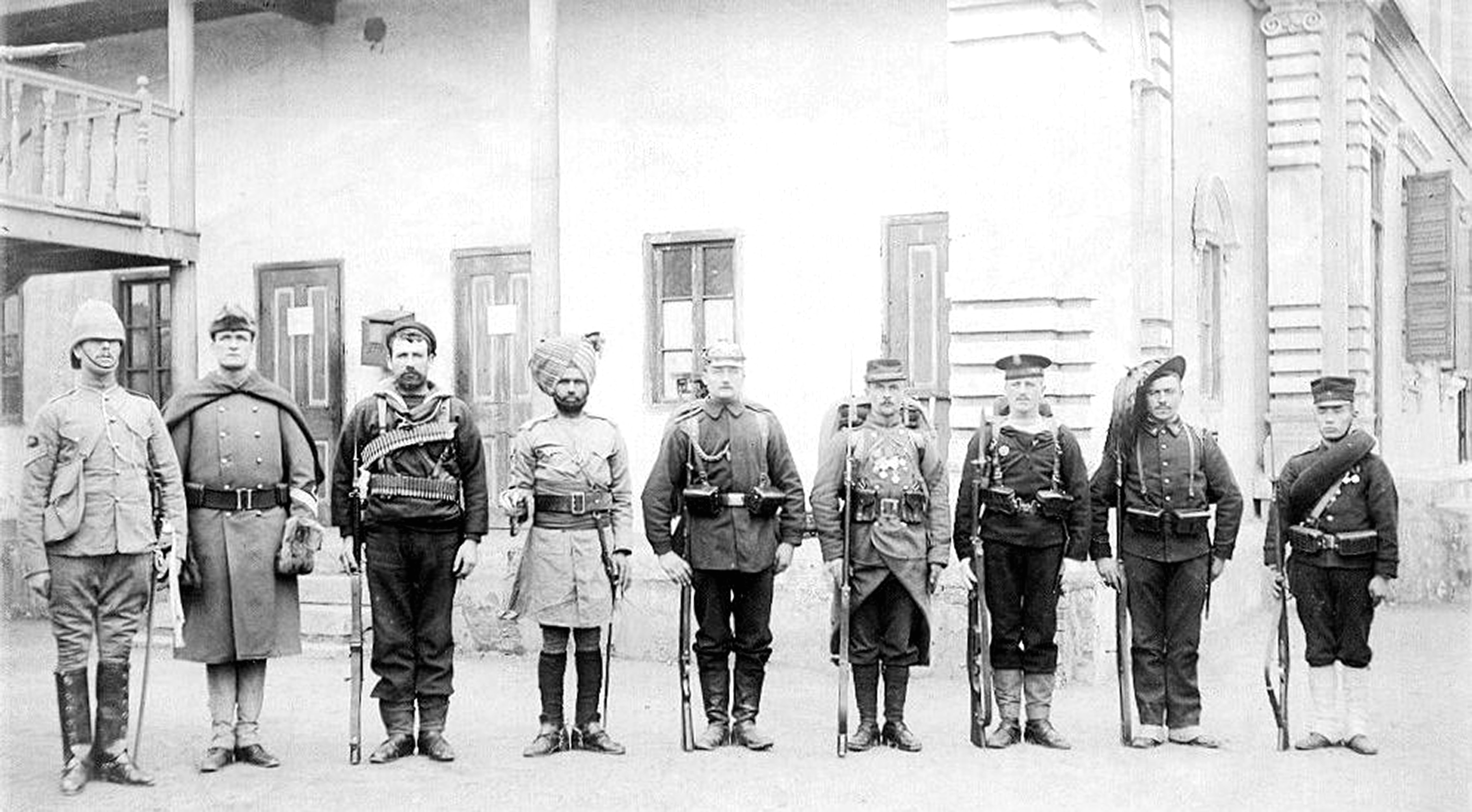
| "Troops of the Eight-Nations Alliance," ca. 1900 Left to right: Britain, United States, Australia, India, Germany, France, Austro-hungarian empire, Italy, Japan. Source: Wikipedia [solders_of_the_eight_nation] |
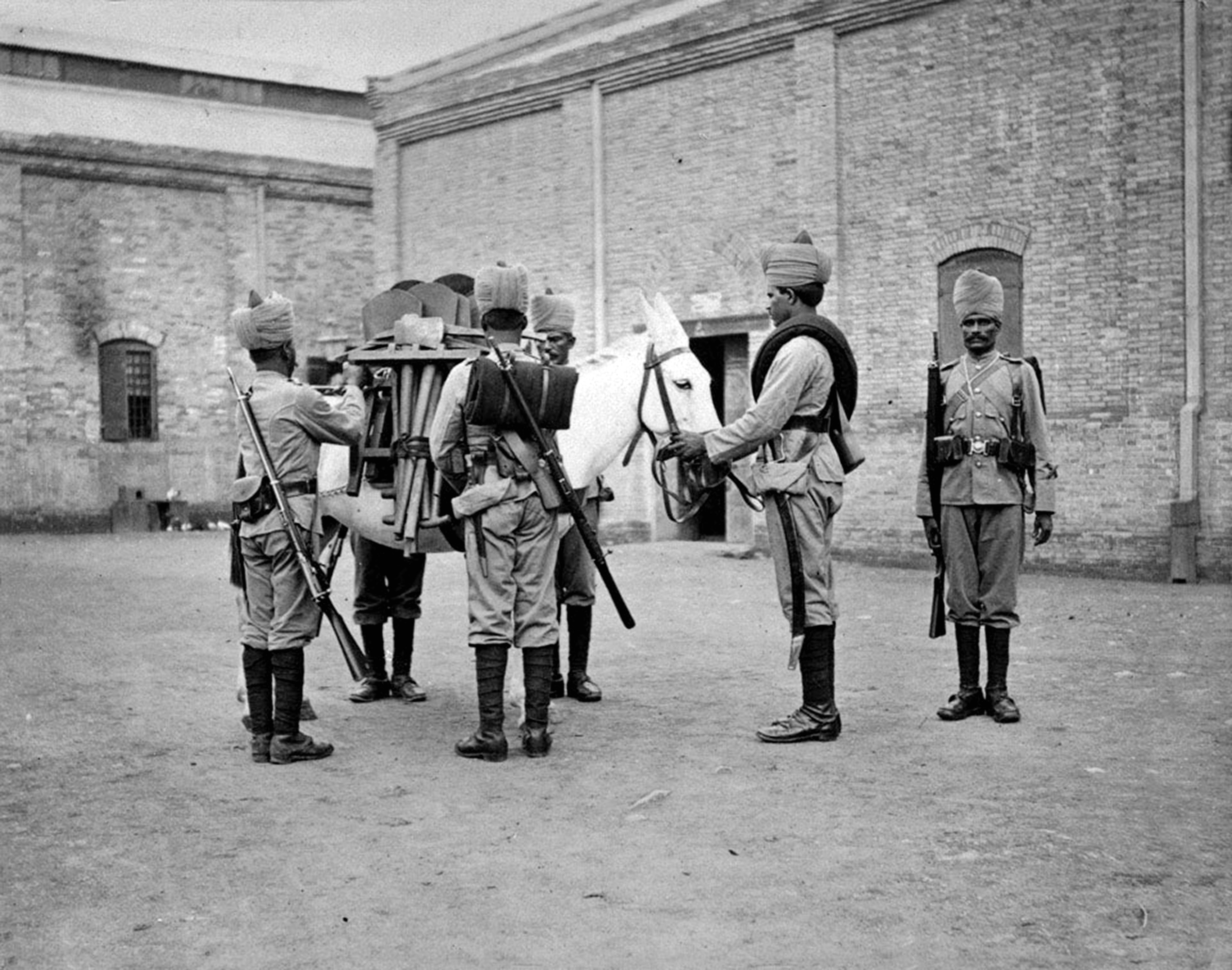
| "No. 2 Company, Bombay Sappers and Miners, China, 1900" Tianjin, 1900 Source: Wikipedia From National Regular army Museum website: "No. ii Company was the final of the sapper and miner units to state in Red china, reaching Tianjin on eleven August 1900. The visitor was employed for a fourth dimension on the Tianjin defenses and on 19 Baronial took office in an engagement to disperse the Boxer forces threatening the city from the south w. Towards the end of 1900 the unit was occupied in the bridging and preparing winter quarters, also as, during the following spring, in demolishing wrecks in the Pei-Ho River." [1900_84115_Bombay_Sappers] |
| The forces left Tianjin on August iv and reached Beijing on August 14, facing very little military resistance, but suffering heavily from heat exhaustion. The strange armies suffered very few casualties. In the side by side 2 days, they occupied and liberated the legation quarter and Northern Cathedral, and on August 28 they staged a march through the city to display their completed occupation. The empress dowager and her courtroom had fled on August fifteen to take refuge in Shanxi. |
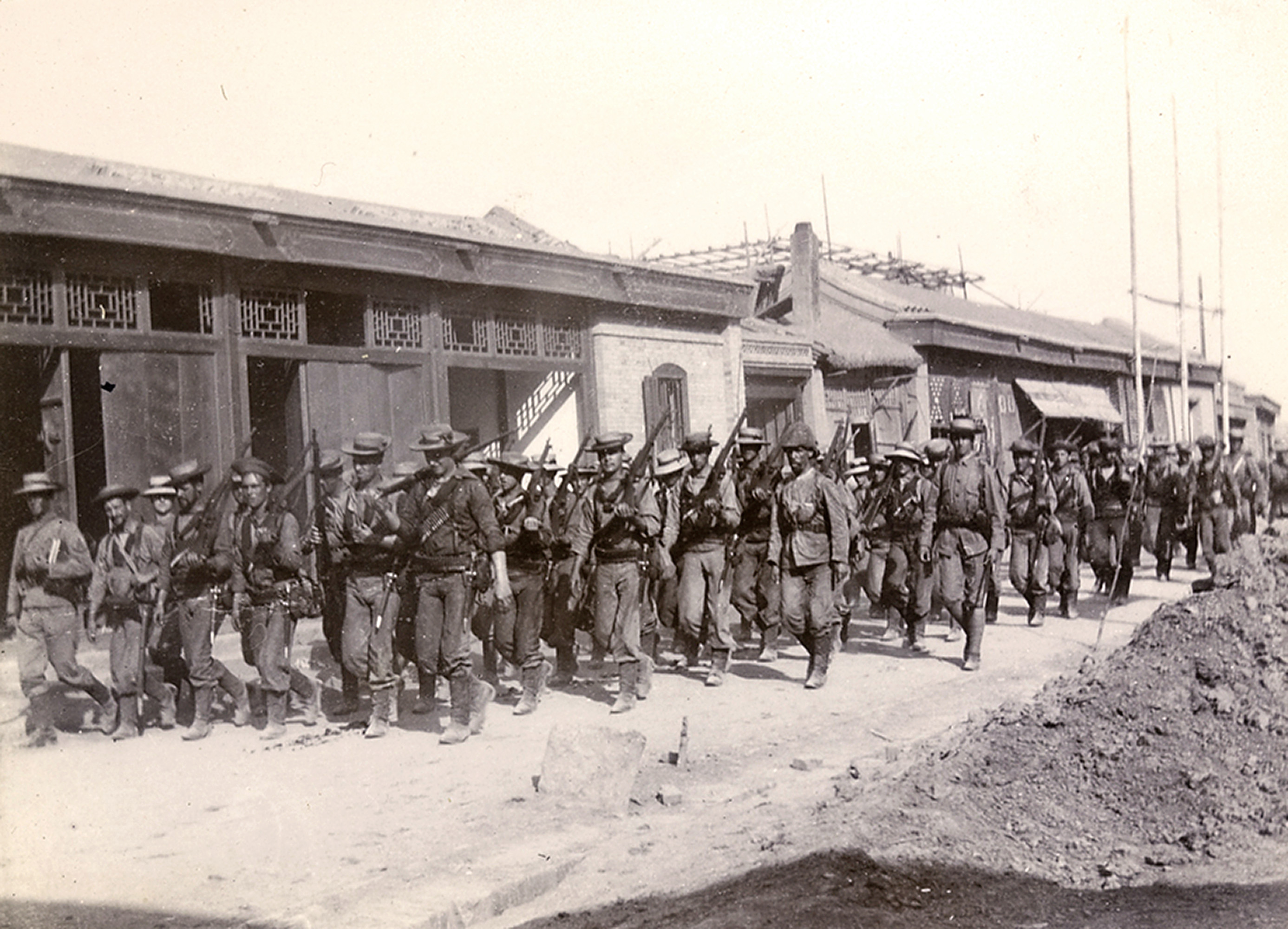
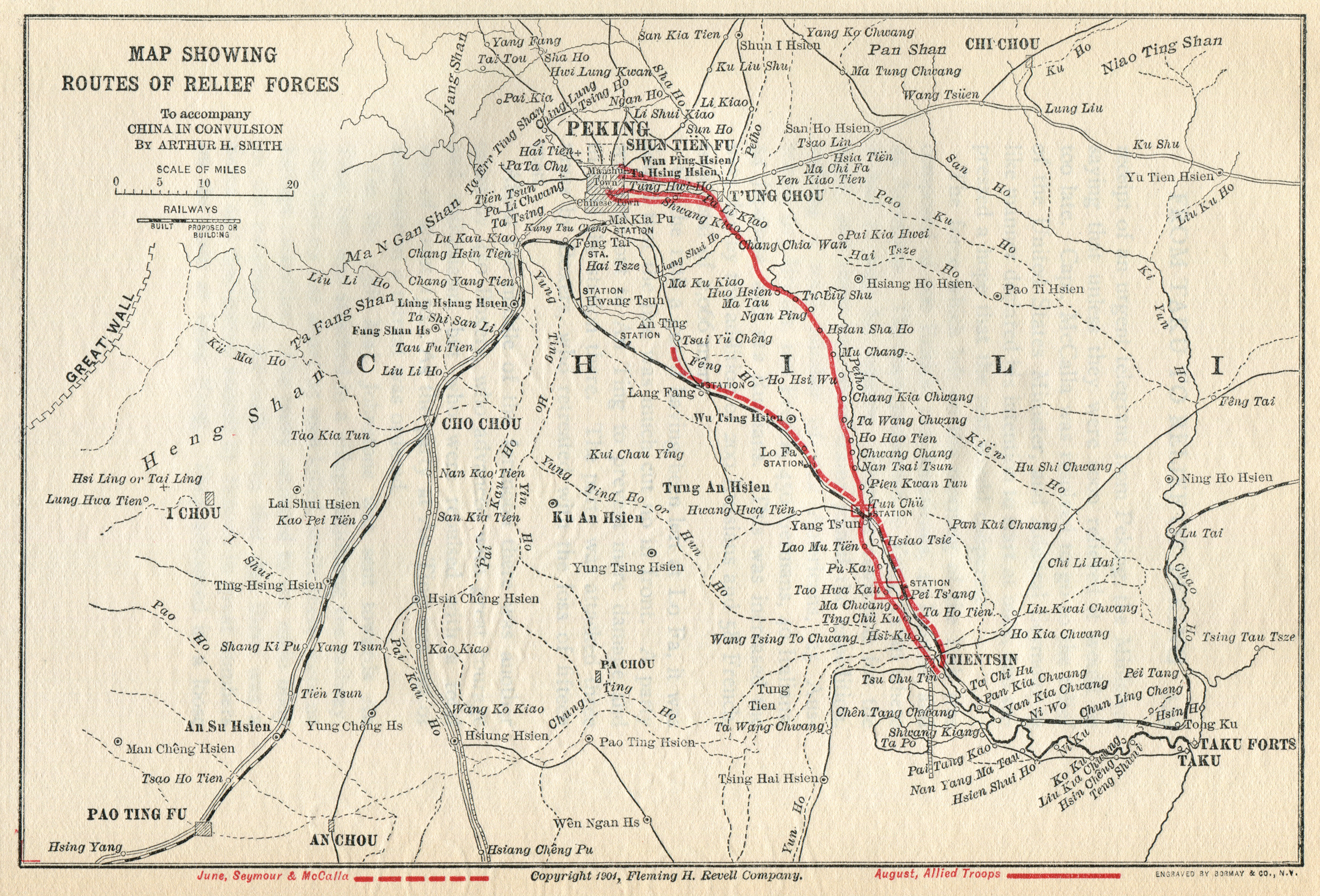
| Two routes followed by Allied expeditions from Tianjin to Beijing. The Seymour trek traveled by train, until defeat, returning over country and past boat. The 2d expedition marched overland next to supply boats on the Hai (Peiho) River. (To a higher place) "Map Showing Routes of Relief Forces. To accompany Prc in Convulsion past Arthur H. Smith," 1901 [smith438a_MapRelief_1901] (Correct) "The March to Pekin" [RevOfRev_1900_v22_014] | |
| At the same time, the Russians sent warships downwards the river into Manchuria, attacking and occupying the three provinces of Heilongjiang, Jilin, and Fengtian. All the foreign journals produced dramatic pictures of the battle for Beijing, each featuring the actions of the troops of their own nation. The battle portraits contain pictures of masses of men fighting in neat confusion, and views of disciplined armies charging toward the massive walls of Beijing. They vary greatly in degrees of realism and fantasy. Many images reinforced existing stereotypes of China as a huge state, with an ancient, but degenerate civilisation, taken over by barbarian hordes. Others showed specific events, demonstrating Western forces triumphing over Chinese soldiers and Boxer militiamen. An amazing array of modern mass media, ranging from newspapers, to leaflets, to advertizing cards contained in consumer products like chocolate and soap, distributed the battle pictures widely. The French magazine Le Petit Periodical featured colored pictures of crowded masses of people, with very trivial depiction of military gore. The French had very few troops in the Eight-Power Army, so they could not brandish their own military machine contributions, simply the French three-colour flag flies prominently among the big military forces. |
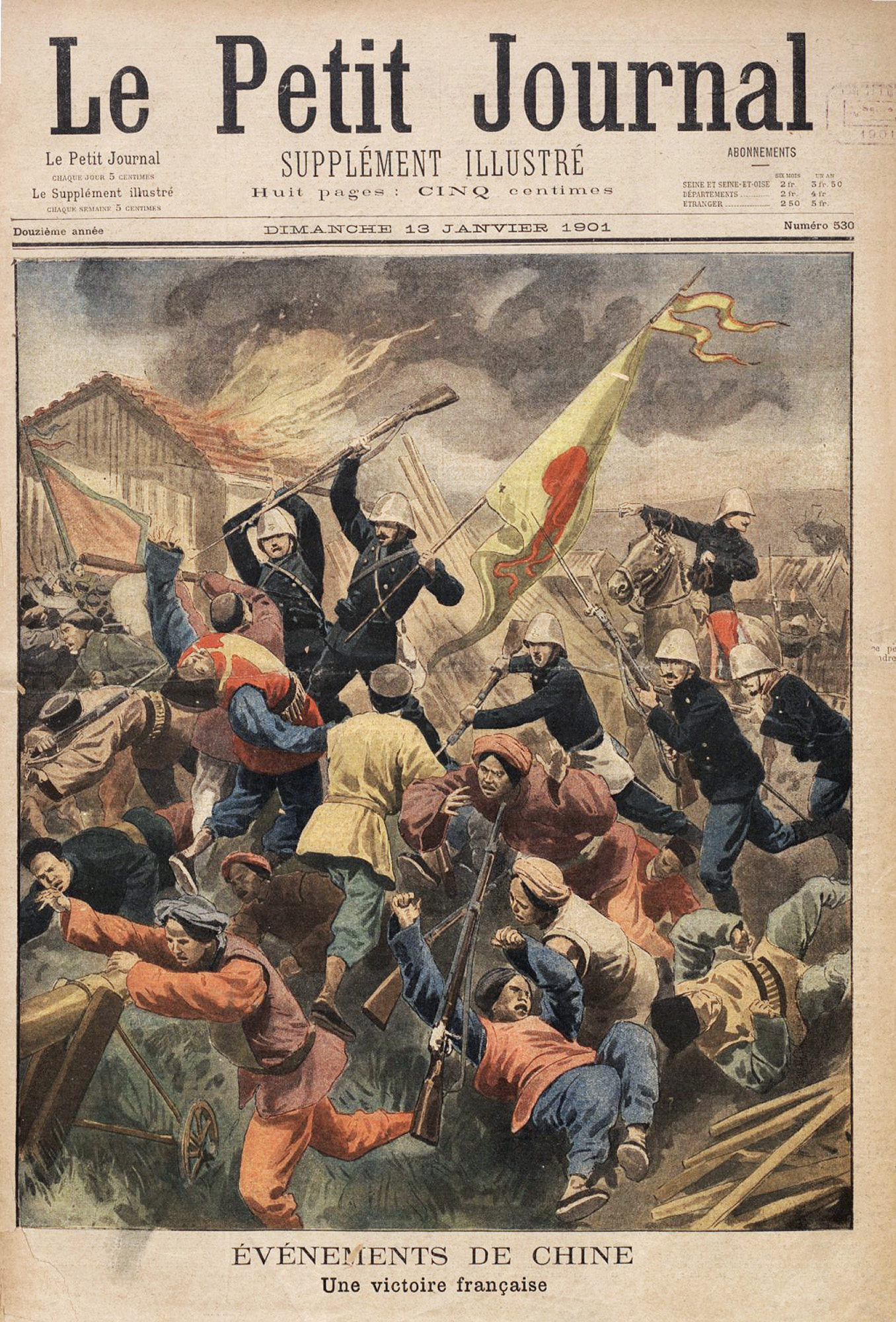
| "Événements de Chine. Une Victoire Française" Le Petit Journal, Supplément Illustré, January 13, 1901 [lpji_1901_01_13th_2] |
| The almost dramatic of all the siege pictures is a French analogy showing close combat between foreigners firing car guns and Chinese storming the wall. (Note that in this movie the Chinese troops apply arms as well, and the image features militarily trained forces instead of Boxer peasants.) |
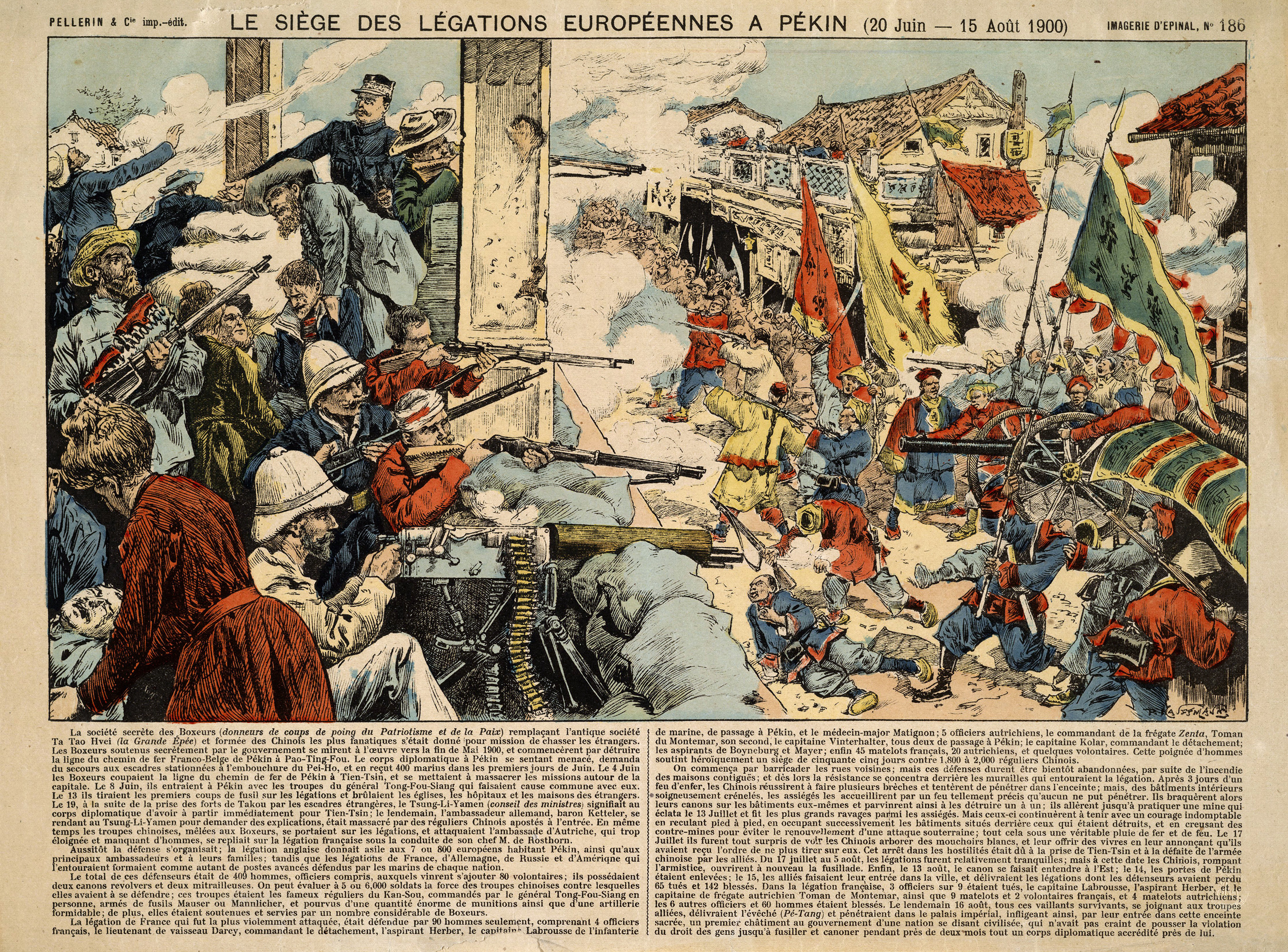
| Not to be outdone, a dramatic Japanese impress celebrates the charge of Japanese troops on the walls of Beijing. Atmospheric views of Beijing seen through clouds of smoke repeat the fanciful illustrations of the Sino-Japanese War by artists who had never seen the forepart. |
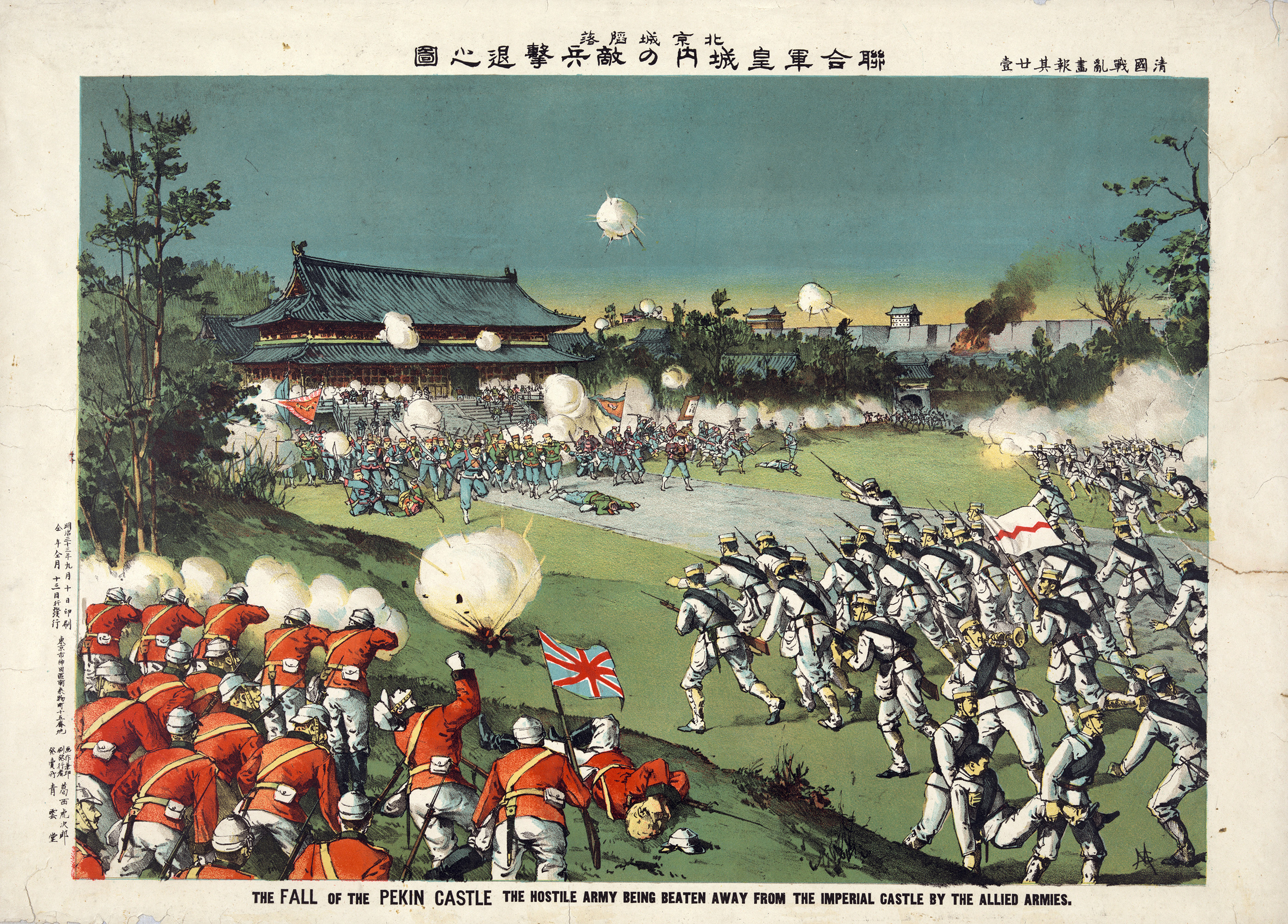
| English language caption on Japanese print: "The fall of the Pekin Castle, the Hostile Army Being Browbeaten Away From the Regal Castle by the Allied Armies." September, 1900 Artist: Kasai Torajirō Source: Library of Congress [j_1900_BeijingCastleBoxerR] |
| Another print depicts Japanese Cherry-red Cantankerous representatives tending to wounded Western soldiers while Japanese officers mingle with the Centrolineal commanders. Nihon asserts its equality with the imperial armies while clouds of smoke breaker over the walls of Beijing in the altitude. |
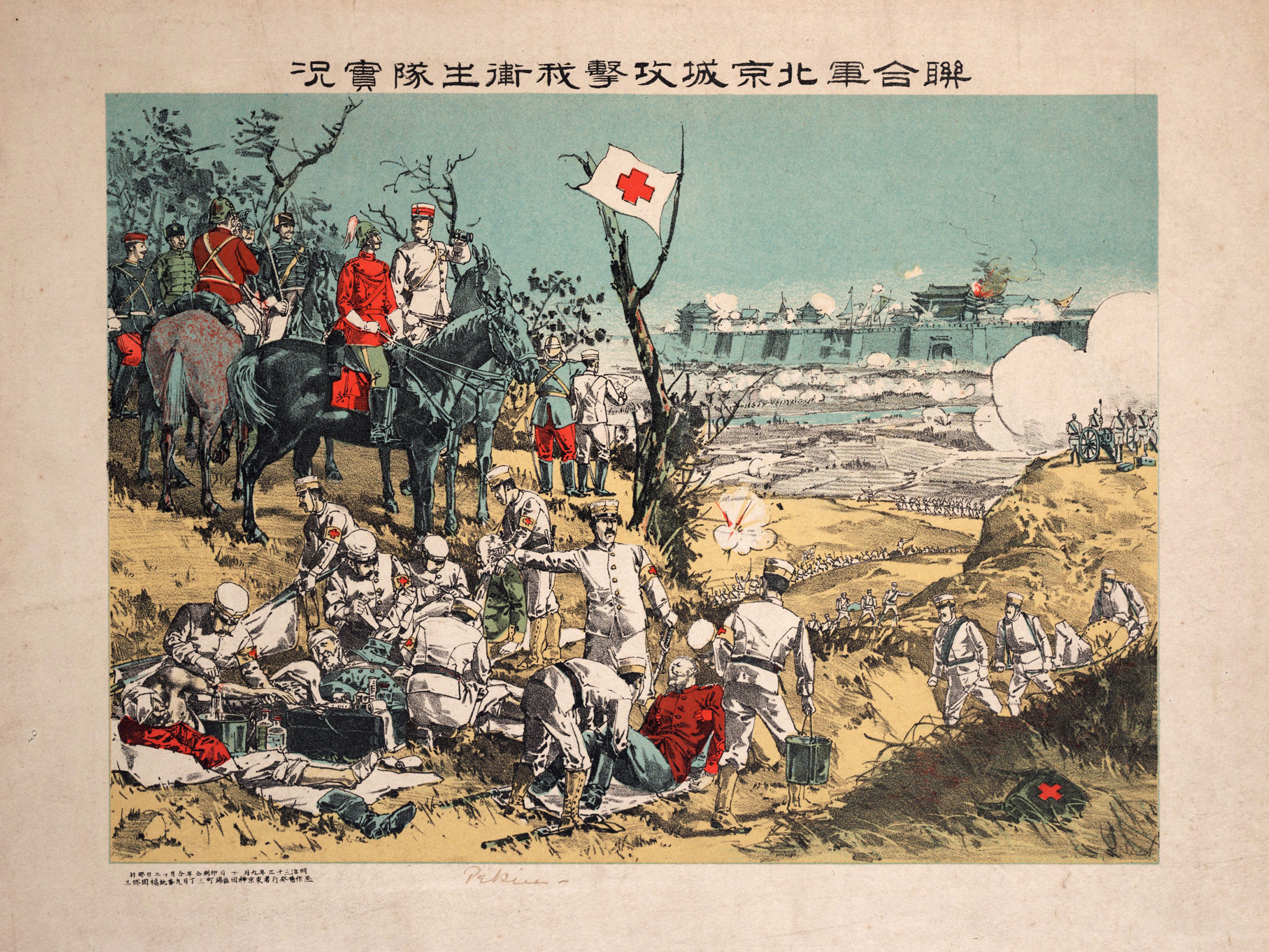
| Japanese imagery did not stress religious themes, and information technology represented both the coercive and the restorative functions of the expedition. In Western imagery, all the same, drawings of attacks on missionaries angry the nearly popular sentiments. Descriptions of Boxer attacks drew explicitly on stories of martyrdom in the Christian tradition dating back to the Elizabethan writer John Foxe'due south Book of Martyrs. Even though details of the events were scanty, information technology was all likewise easy to fit the Boxer attacks into a narrative that followed closely the 16th-century hagiographic text, in which all Christians, foreigners and Chinese alike, were innocent, heroic victims of savage brutality. Depictions of Boxers massacring Western missionaries appeared alongside Western retaliation with looting and destruction of government buildings, giving viewers a sense of righteous revenge. But in this narrative, social club presently returned, with the troops marching into the Forbidden City and the besieged missionaries gratefully receiving their liberators. |
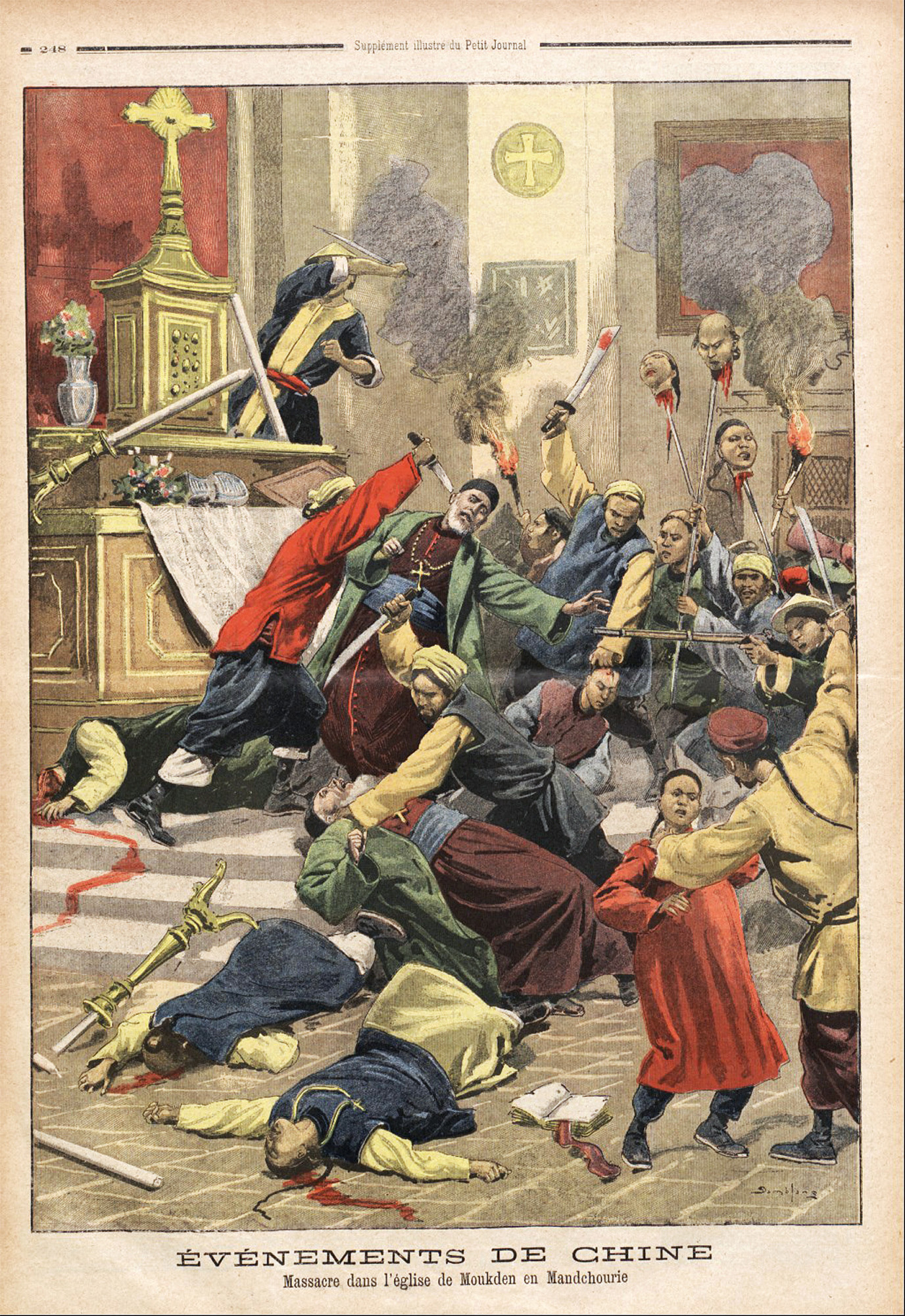
| Massacre of the Russian missionaries."Événements de Chine. Massacre dans 50' Église de Moukden en Mandchourie" [sic] Translation: "Massacre in the Mukden Church in Manchuria" Le Petit Periodical, Supplément Illustré, Baronial 5, 1900 [lpji_1900_08_05th_9] |
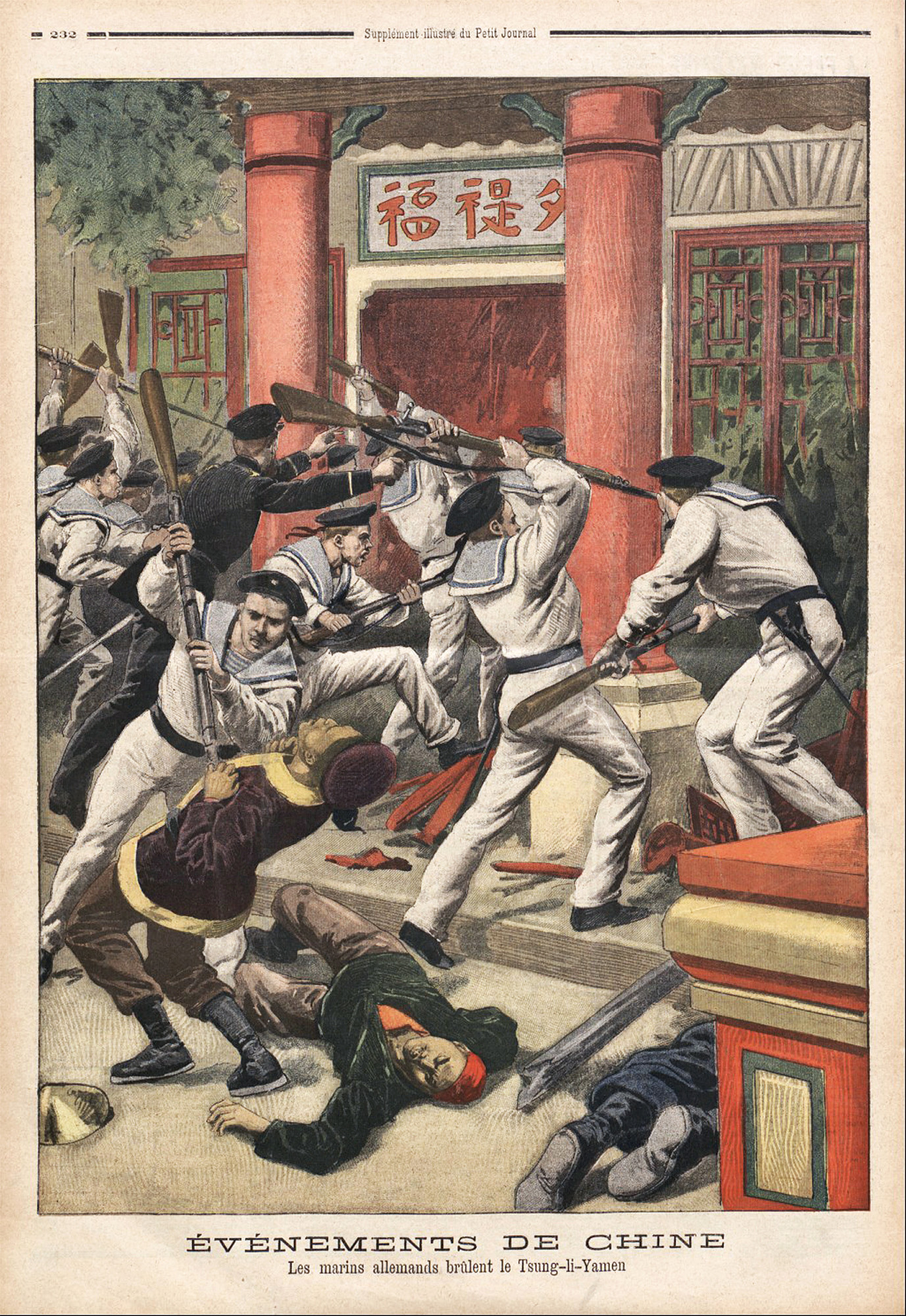
| "Événements de Chine. Les Marins Allemands Brulent le Tsung-li-Yamen." Translation: "German Sailors Fire Tsung-li-Yamen" Le Petit Journal, Supplément Illustré, July 22, 1900 [lpji_1900_07_22nd_9] |
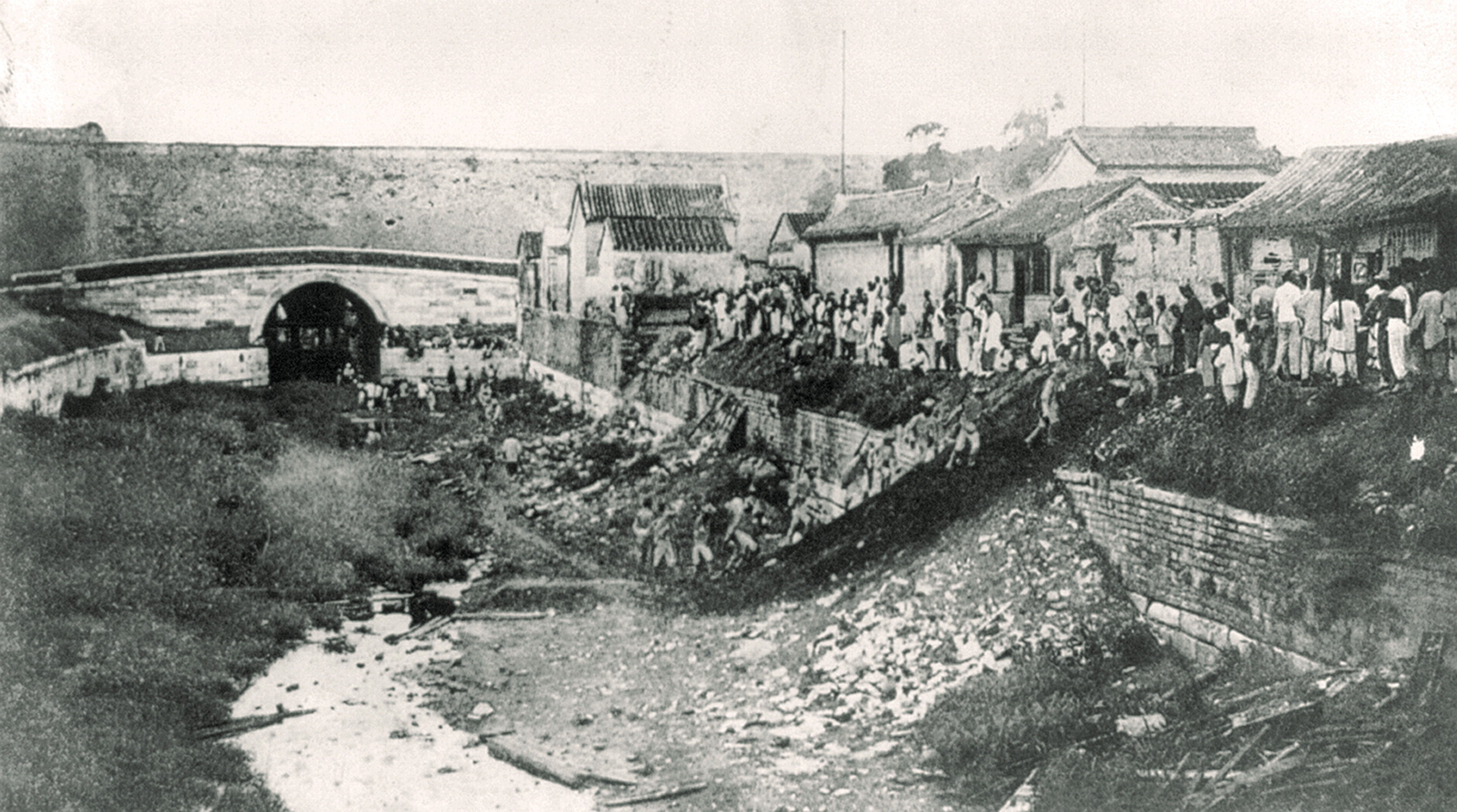
| Water gate through which British forces walked, the kickoff to attain the legations. Source: Library of Congress [libc_1900_3a49563u] |
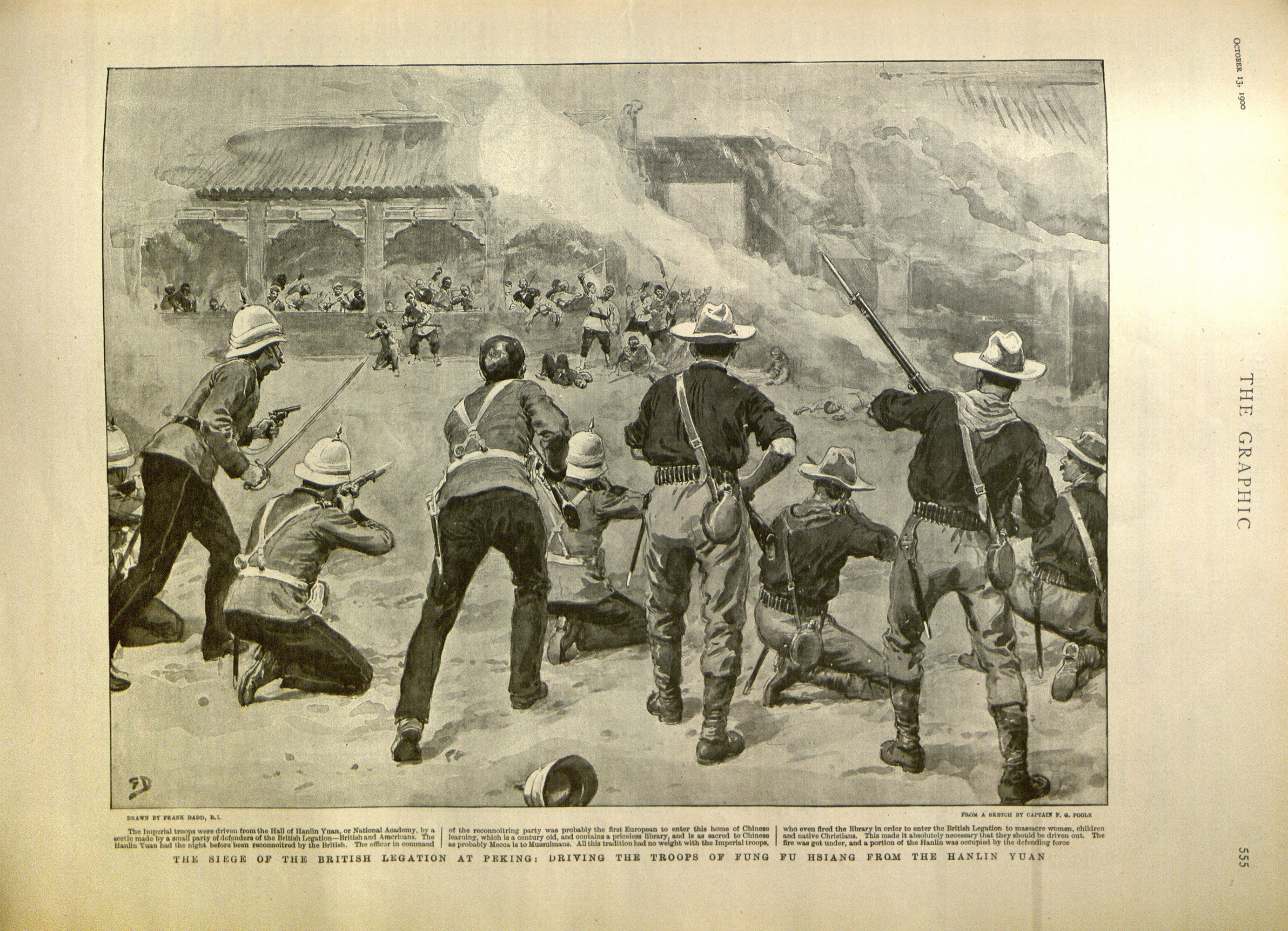
| "The Site of the British Legation at Peking; Driving the Troops of Fung Fu Hsiang [Dong Fuxiang] From the Hanlin Yuan. The Regal troops were driven from the Hall of the Hanlin Yuan, or National Academy, by a sortie made by a small party of defenders of the British legation—British and American. The Hanlin Yuan had the dark before been reconnoitred by the British. The officer in command of the reconnoitring party was probably the first European to enter this home of Chinese learning, which is a century old, and contains a priceless library, and is as sacred to Chinese every bit probably Mecca is to Musulmans. All this tradition had no weight with the Regal troops, who even fired the library in order to enter the British Legation to massacre women, children and native Christians. This fabricated it admittedly necessary that they should be driven out. The burn was got under [control], and a portion of the Hanlin was occupied by the defending force." The Graphic, October 13, 1900 [graphic_1900_049] |
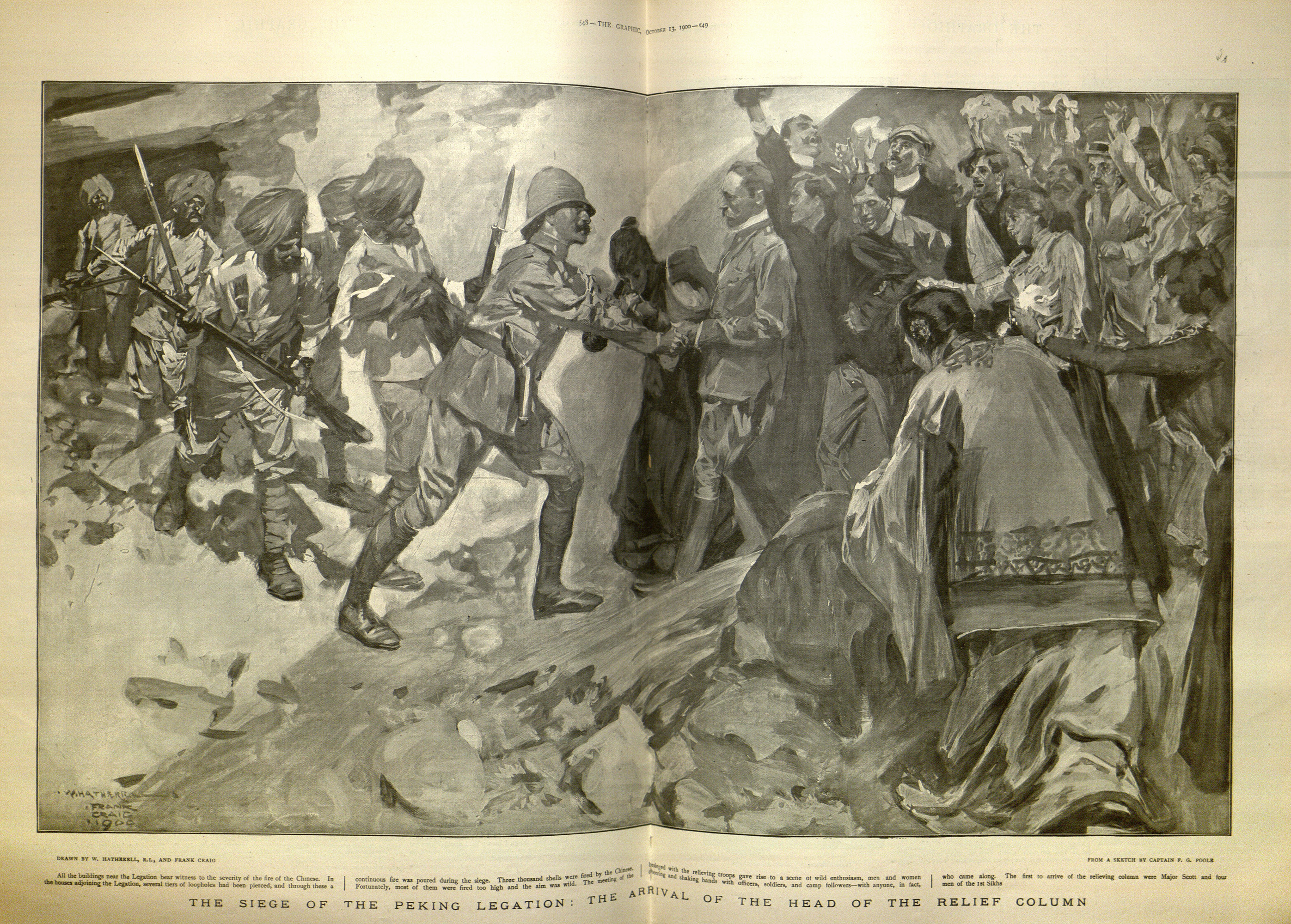
| "The Siege of the Peking Legation: the Arrival of the Head of the Relief Column. All the buildings near the Legation comport witness to the severity of the burn of the Chinese. In the houses adjoining the Legation, several tiers of loopholes had been pierced, and through these a continuous burn was poured during the siege. 3 1000 shells were fired past the Chinese. Fortunately, about of them were fired too high and the aim was wild. The meeting of the besieged with the relieving troops gave ascent to a scene of wild enthusiasm, men and women auspicious and shaking hands with officers, soldiers, and camp followers—with anyone, in fact, who came forth. The first to arrive of the relieving column were Major Scott and 4 men of the 1st Sikhs." The Graphic, October 13, 1900 Artists: Westward. Hatherell, R.I., & Frank Craig, from a sketch by Captain F. M. Poole [graphic_1900_048] |
| |


mazincusithedeweese1.blogspot.com
Source: https://visualizingcultures.mit.edu/boxer_uprising_02/bx2_essay01.html
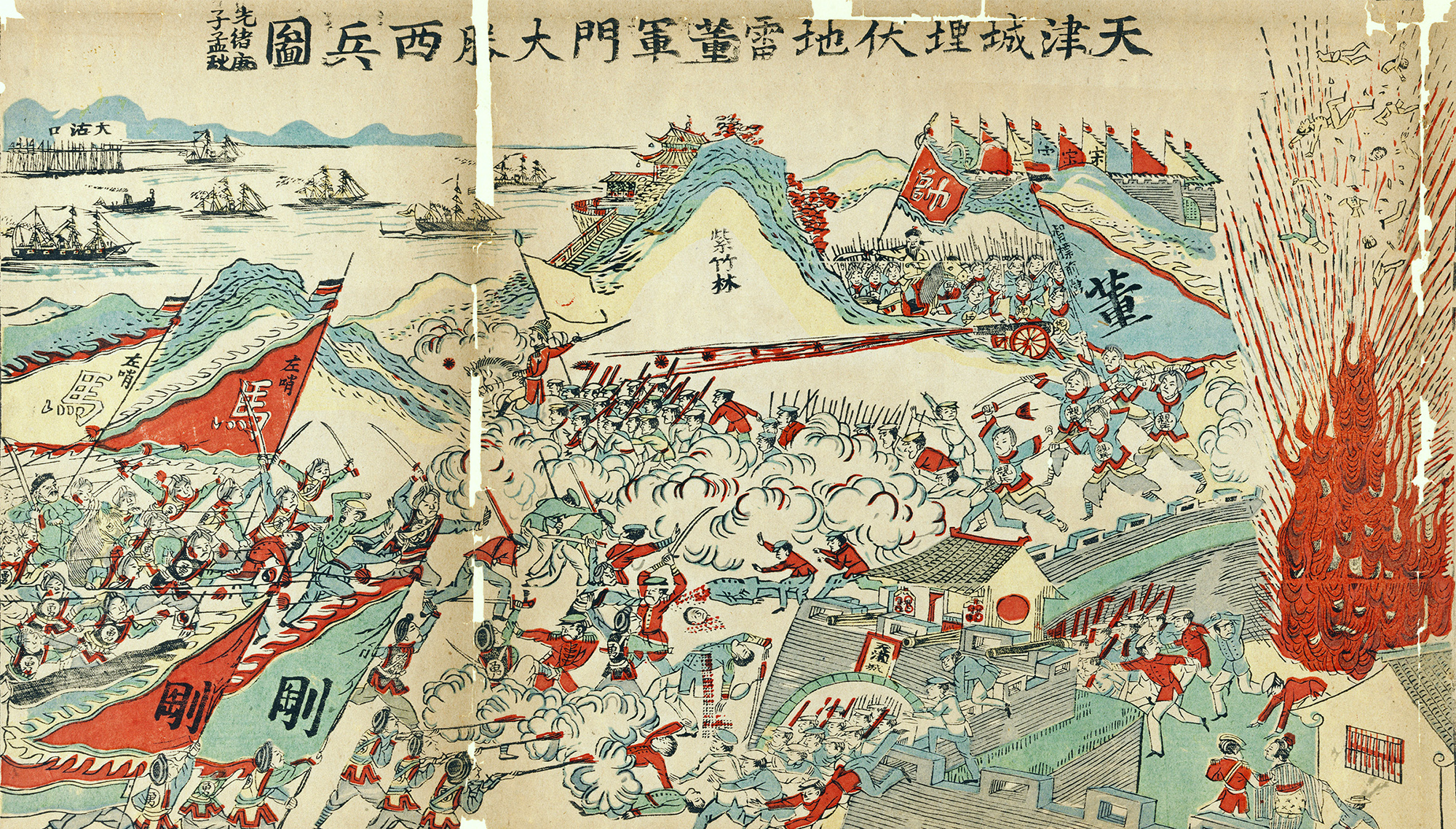
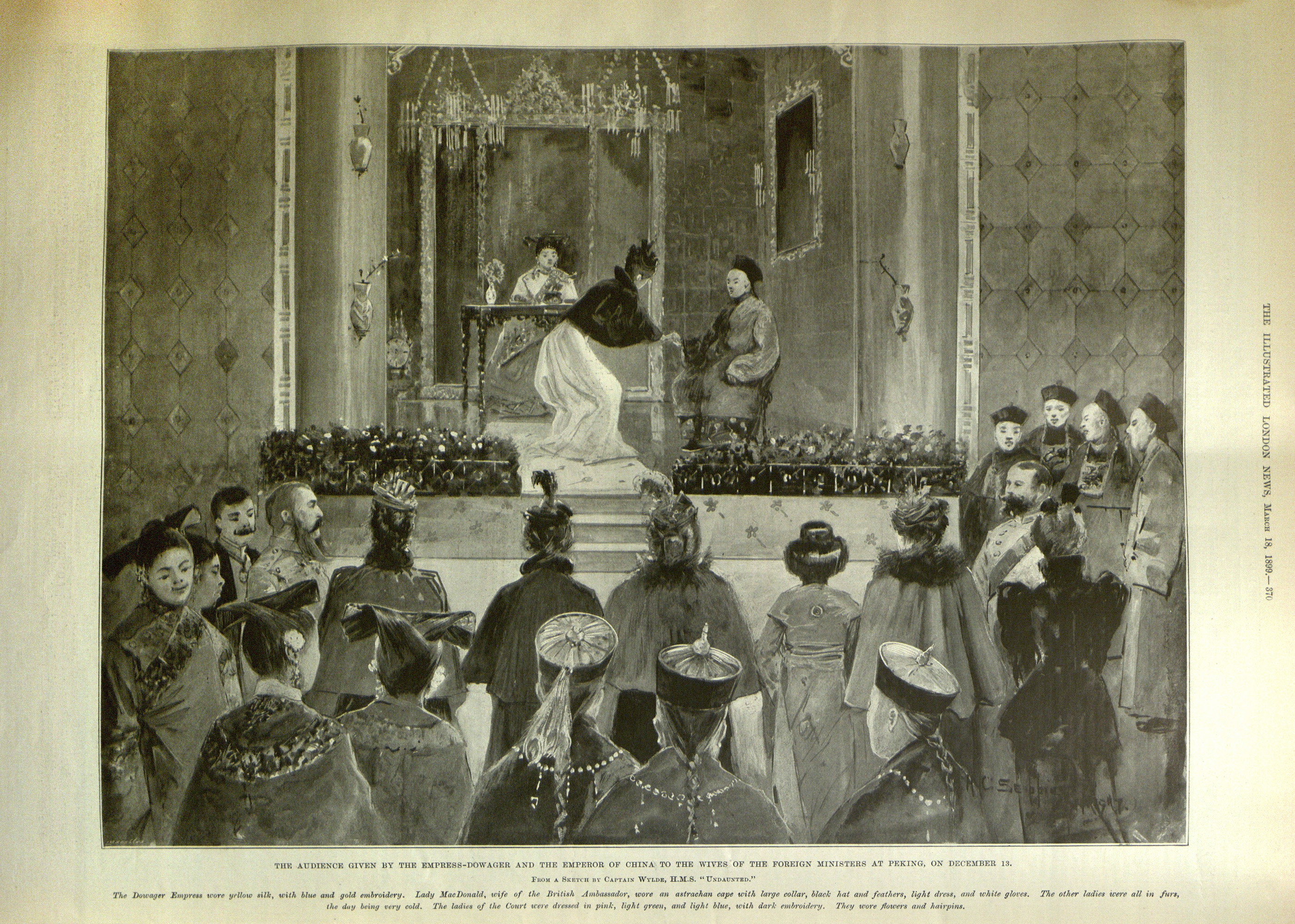
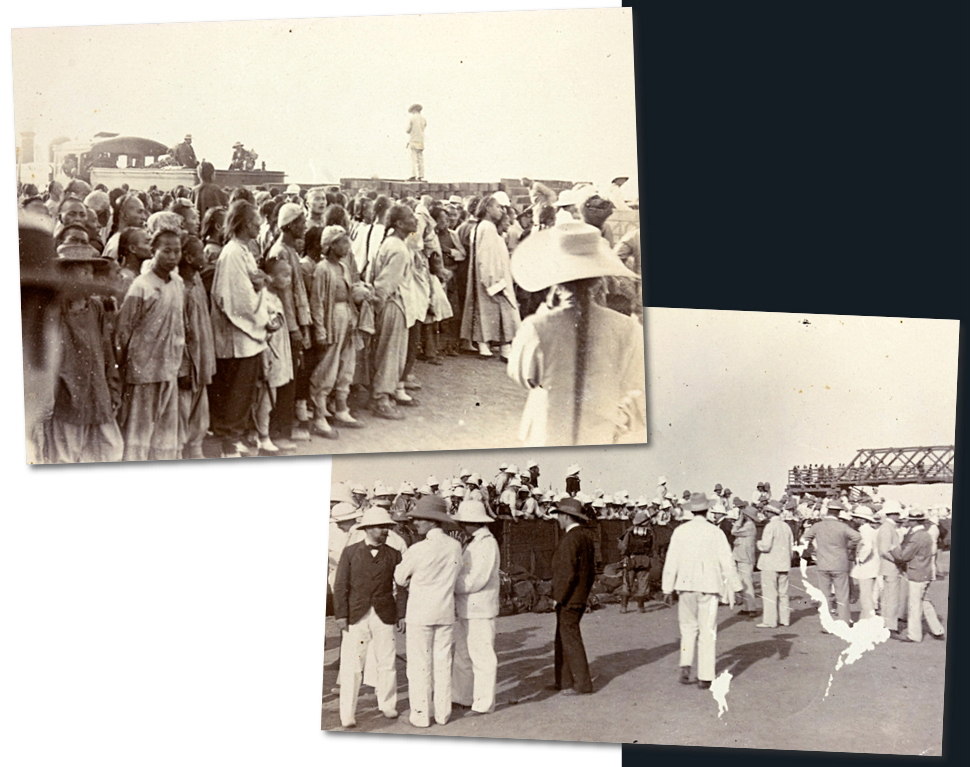
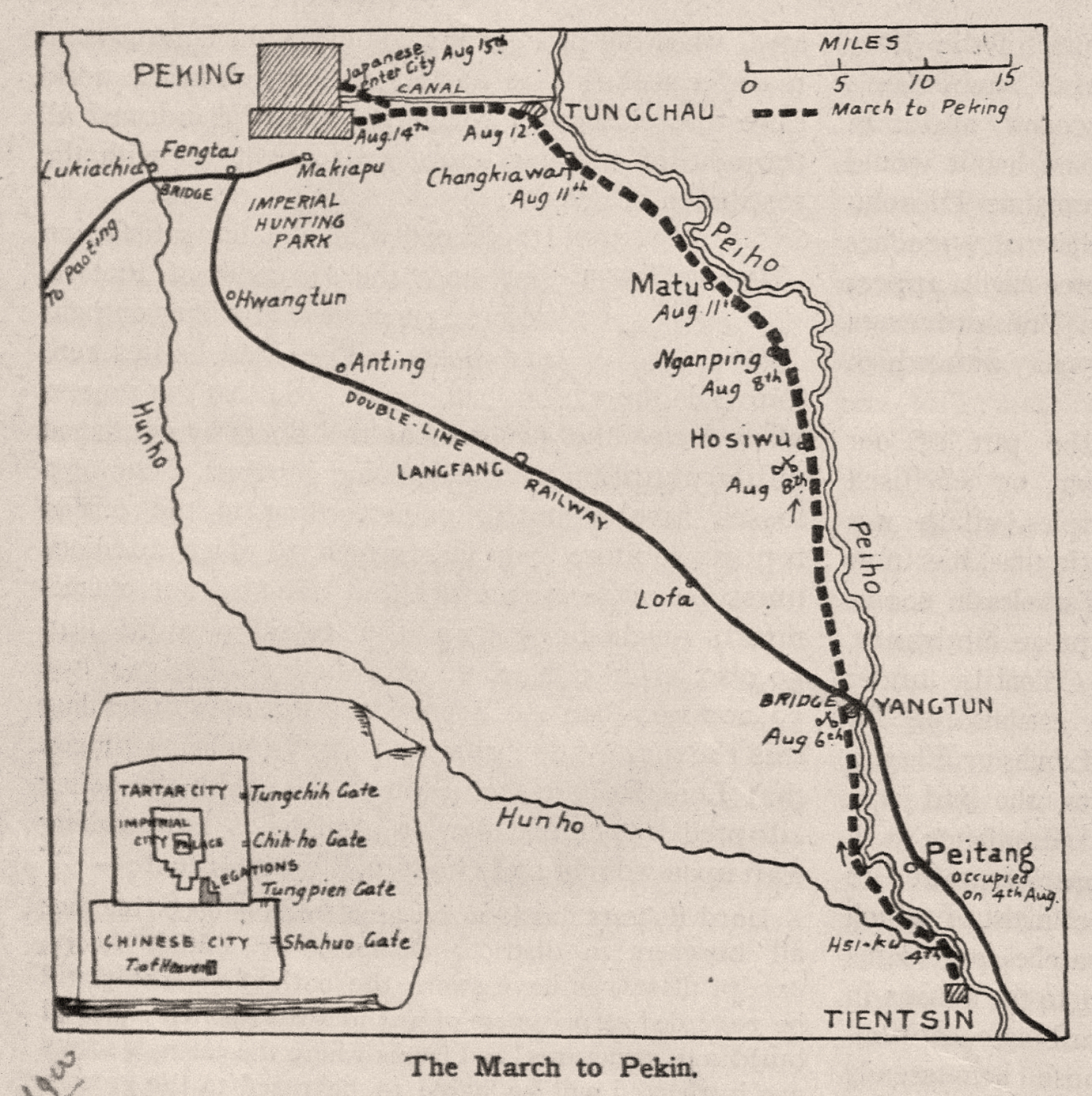



Komentar
Posting Komentar